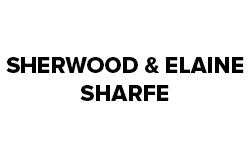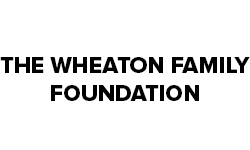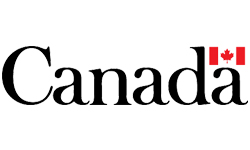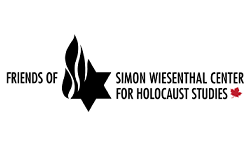GRADE 5 RESOURCES
The Intentional & Direct Teaching of Essential Citizenship Competencies



GRADE 5 CITIZENSHIP STUDIES ENGAGED CITIZENS
Part A: Curricular Connections and Background
BROAD AREA OF CITIZENSHIP
OVERVIEW AND DESIRED RESULTS OF CITIZENSHIP STUDY
- Exploring the relationships between beliefs, rights, and responsibilities on a school, community, and national level;
- Understanding the different types of governance at the local and national levels; and,
- Understanding and valuing the historical and contemporary diversity in groups.
Students will extend their exploration of rules and societal order to the workings of the various governing systems in Canada including First Nations and Métis governance and those patterned on the Westminster parliamentary systems. Students will extend their understanding of the impact of the differing levels of government and develop a greater understanding of the nature of the treaty relationships between the First Nations and Canada’s federal government. Finally students will examine the role of diversity and multiculturalism in the development of the Canadian persona/identity.
ENDURING UNDERSTANDINGS OF CITIZENSHIP STUDY
- Decision-making is a complex process with far-reaching impacts and is influenced by history.
- A person’s worldview frames their understanding of the world.
- Citizens value the need of the collective common good and consider how their actions impact the collective well-being.
- Governments and the people who elect them are responsible to one another.
- Empathy and respect for diversity in cultural and social groups help strengthen one’s community and requires appreciation of different perspectives.
- Individuals have the power to affect others and make a difference.
- Canada has a constitutional responsibility to support First Nation, Métis and Inuit people.
- Societies create rules, written and unwritten, to promote order that lead to inclusion or exclusion and are enforced by social behaviours and expectations.
- Belonging requires participation and is a fundamental right of all citizens.
- Active citizens become engaged in discussions, negotiations, debates and consider action regarding Canadian issues.
- Enduring understandings are the big ideas that stimulate thinking, guide the inquiry and are linked to outcomes.
- Essential questions point to the “big ideas’ in the inquiry and should be considered and reconsidered as the inquiry progresses.
- Answers to these questions form the evidence of learning at the end of study.
KNOWLEDGE AND SKILL DEVELOPMENT
- Determine the governing body and the rules/laws they develop so they can determine fairness, sphere of influence, and advocate effectively to support or change the rules/laws
- Determine the impact of rules on diverse groups that live in Canada
- Determine the sphere of influence of rules that govern behavior of the people of Canada
ESSENTIAL QUESTIONS
- What are the organizing structures to support society living together?
- Why do we need rules? How much do rules matter?
- Who monitors the rule makers/members of governance bodies?
- How much power should leaders have?
- To whom are leaders/rule makers responsible?
- Why are treaty relationships important to all Canadians?
- What role does affirmation of diversity play in Canadian identity?
CURRICULUM OUTCOMES AND INDICATORS
Outcomes: (Sask. Curriculum/Student Friendly)
PA5.2
Explain the purposes and functions of governance structures in Canada, including Métis and First Nations systems and those patterned on the Westminster parliamentary systems.
Indicators:
- Represent, in graphic format, the structure of various levels of government in Canada, including municipal, First Nations, Métis, provincial, territorial, and federal governments.
- Investigate the structure of First Nations governments in Canada, using accurate terminology (e.g., elected chief, hereditary chief, First Nation, band, band council, treaty, self-government).
- Investigate the structure of Métis governance structure and its origin with the laws of the buffalo hunt.
- Develop an understanding of the functions of the following governance bodies and the role of those in leadership positions: House of Commons, Senate, Governor General, Prime Minister, member of the federal parliament, government minister.
PA5.3
Develop an understanding of the nature of the treaty relationship between First Nations and Canada’s federal government.
Indicators:
- Explain what a treaty is, and the purpose of a treaty.
- Affirm that all Saskatchewan residents are treaty people.
- Investigate the spirit and intent of the treaties from the perspective of the Crown and the First Nations in Western Canada.
- Undertake an inquiry to examine the extent to which treaty promises have been met by parties to the treaties, and why the fulfillment of treaty obligations is important for all Canadians
IN5.1
Demonstrate an understanding of the Indigenous heritage of Canada.
Indicators:
- Locate on a map traditional First Nations and Inuit habitation areas in the era prior to European arrival, including the Northwest Pacific Coast, Interior Plateau, Plains, Eastern Woodland, Sub Arctic, and Arctic.
- Research similarities and differences in ways of life among First Nations and Inuit communities prior to European contact (e.g., men’s roles, women’s roles, children’s roles).
- Investigate the significant events and principle First Nations and Inuit leaders prior to and during the period of initial contact with Europeans.
- Assess the coming together of First Nations peoples with the French and British explorers and settlers, including the effect of the fur trade on the First Nations and the Métis in early Canada.
- Trace the evolution of the Métis in Canada, including their origins, language, and major historical events (e.g., the Métis of Red River, the North West Resistance).
- Investigate how the Red River Métis came to see themselves as a distinct nation within Canada.
- Paraphrase a traditional narrative about the origins of the First Nations or Inuit peoples, about the relationship with the natural environment, and connections between spirituality and the natural environment.
IN5.2.
Analyze the evolution of Canada as a multicultural nation.
Indicators:
- Describe Canada’s historical and current demographics, including population numbers, age, and location.
- Identify trends and challenges in Canada’s demographics.
- Differentiate between refugees and immigrants.
- Explain what motivates newcomers to move to Canada (e.g., entrepreneurship, employment, family reunification, refuge, education, reputation as a good place to live).
- Undertake an inquiry which compares the immigration policies and practices of the 19th century to those of the current era, and assess the results of those policies and practices.
- Identify the goals of various ethnic and cultural advocacy organizations in Canada, including First Nations, Inuit, and Métis organizations, as well as organizations supporting new immigrants to Canada.
- Identify the historic origins of a variety of place names in Canada, and investigate the reason for the naming.
- Graphically display the country of origin of immigrants to Canada in the 19th and 21st centuries, and account for similarities and differences in the two eras.
- Examine the Canadian government treatment of various groups of immigrants to Canada (e.g., Chinese immigrants in the 1800s, Japanese Canadians in the 1930s and 1940s, Eastern European immigrants in the late 19th and early 20th century)
TEACHER BACKGROUND
- Treaty Essential Learnings: We Are All Treaty People (pages 16-17)
- Treaty areas of Canada and First Nations within those treaty areas
- First Nations not under treaty – names and geographic areas
- Structures of Indigenous governance groups i.e. Assembly of First Nations (AFN), Federation of Sovereign Indian Nations, Métis National Council, Congress of Indigenous Peoples, Métis Nation – Saskatchewan
Part B: Learning Plan
- Demonstration of an understanding of the Indigenous heritage of Canada.
- Analysis of the evolution of Canada as a multicultural nation.
Teacher Note
This next area of study is approached through the lens of diversity and the application and examination of the policy of multiculturalism adopted by Canada in 1971. The history of Canada has traditionally been studied through a Euro-centric filter. Consequently, although First Nations people are part of the founding cultures of Saskatchewan and Canada they still continue to be treated as an alternate culture outside of mainstream society. By examining Canada’s policy on multiculturalism it is hoped that students will begin to question the separation that occurs when it comes to respecting and appreciating the contributions of First Nation, Inuit and Métis cultures and heritage as a significant part of Canada’s strength.
QUESTIONS TO GUIDE INQUIRY
Teachers may want to consider putting the questions into a “Before, During, After” chart to note the changes in students’ thinking as a result of the inquiries.
- What role does affirmation of diversity play in the Canadian identity?
- How does empathy contribute to Citizenship?
- What is the relationship between treaty responsibilities and respect for diversity?
- Why are treaty relationships important to all Canadians?
- What is our Canadian responsibility to treaties?
- Why did Canada negotiate treaties with only some First Nations?
- Why were Métis offered scrip as a means to extinguish their land rights?
- How are the benefits of treaties active in your life?
- How are treaties fair?
- How do treaties benefit all Canadians?
Vocabulary
- diversity
- refugee
- immigrant/ immigration
- multicultural
- demographics
- policy
- ethnic
- cultural
- advisory
- assimilation
- colonialism
- integration
- cross-cultural
- racial
CONNECT TO TOPIC AND SURFACE STUDENTS’ THINKING ABOUT …
Pose the essential questions and allow students to discuss their thought on the matter.
Canada was one of the first countries to adopt an official policy of Multiculturalism.
The following 5 point Likert scale survey is created from statements taken from Canada’s official policy on Multiculturalism obtained from the web address below.
It forces students to examine their beliefs about other cultures and multiculturalism. This survey can be done pre and post inquiry.
5 point Likert scale
1. Agree strongly 2. Agree 3. No comment 4. Disagree 5. Strongly disagree
1. Multiculturalism encourages racial and ethnic harmony and cross-cultural understanding.
2. All Canadians are guaranteed equality before the law and equality of opportunity regardless of their origins.
3. Canada’s diversity is a national asset.
4. Canadian citizenship gives us equal rights and equal responsibilities.
5. Canada recognizes the potential of all Canadians, encouraging them to integrate into their society and take an active part in its social, cultural, economic and political affairs.
- Would people of all cultures and ancestry answer the questions the same way? i.e First Nations perspective, Métis perspective, new Canadian perspective, French-Canadian perspective?
- What questions do students have about these statements?
- Why do people move to Canada? Why do people find Canada appealing? Do people always have a choice in moving here?
- Imagine you are new to Canada, what are your first concerns?
DEVELOPING UNDERSTANDING
- Newcomers to the community
- Chairperson or members of School Community Council
- Welcome Wagon
- Open Door Society
- Elders
- Traditional Knowledge Keepers
- Office of the Treaty Commissioner
Jigsaw Research and Study Process
Divide class into groups and give each group a specific Indigenous group to learn about and present to class. Each group must find out the information in the question posed below. Encourage students to present information learned in a variety of modes including speaking, writing, drama, multimedia, or other modes so that all students have an entrance point for demonstrating their learning and understanding.
Indigenous heritages of Canada. Indigenous groups studied:
- First Nations
- Inuit
- Métis
Research and:
- Map traditional habitation areas
- Northwest Pacific Coast,
- Interior Plateau,
- Plains,
- Eastern Woodland,
- Sub Arctic, and Arctic
- Métis areas.
- Trace evolution in Canada – origins, language, and major historical events.
- Identify significant events and principle leaders.
- Identify similarities and differences in ways of life i.e. men’s roles, women’s roles, children’s roles.
- Paraphrase a traditional narrative:
- origins of the Indigenous peoples
- relationship with the natural environment
- connections between spirituality and the natural environment.
- Identify connections to historic origins of place names in Canada, and reason/background for the naming.
- Why are treaty relationships important to all Canadians?
- What is our Canadian responsibility to treaties?
- Why did Canada negotiate treaties with only some First Nations?
- Why did Canada offer scrip to Métis people to extinguish their land rights?
- How are the benefits of treaties active in your life?
- How are treaties fair?
- How do treaties benefit all Canadians?
Make sure students understand the difference between refugees and immigrants before undertaking the following research.
Analyze the evolution of Canada as a multicultural nation.
Divide students into groups and have them each research and present on one of the areas below.
Study 1
- Trace Canada’s historical and current demographics
- population numbers, age, and location
- trends and challenges in Canada’s demographics
- country of origin of immigrants to Canada in the 19th and 21st centuries
- similarities and differences in the two eras
- Give a summary statement for each area of study.
Study 2
- Identify the variety of reasons why immigrants come to Canada.
- Push Pull Factors
- Compare immigration policies and practices- 19th century – current.
- Identify the goals or what the policies were hoping to accomplish
- Assess results of policies and practices
- e.g., entrepreneurship, employment, family reunification, refuge, education, reputation as a good place to live
Study 3
- Identify the variety of ethnic and cultural advocacy organizations in Canada.
- Identify the goals of ethnic and cultural advocacy organizations in Canada.
- First Nations, Inuit, and Métis organizations,
- New immigrants
- List the historic origins of place names in Canada, and explain the reason for the naming.
Study 4
- Research the Canadian government’s treatment of various groups of immigrants to Canada.
- Chinese immigrants in the 1800s,
- Japanese Canadians in the 1930s and 1940s,
- Eastern European immigrants in the late 19th and early 20th century
- Research the Canadian government’s treatment of First Nations children in residential schools.
- Prepare a summary statement identifying the similarities and differences in the treatment of all groups studied.
- How does Canada’s multicultural policy compare against the actions of the Canadian government toward the groups studied?
- What role does celebration of diversity play in the Canadian identity?
- How does empathy contribute to Citizenship?
- What is the relationship between treaty responsibilities and respect for diversity?
APPLY AND EXTEND KNOWLEDGE
- Students can investigate and reflect upon personally relevant issues and beyond. Using articles from local papers including Eagle Feather News, have students follow a current Canadian issue that involves a government decision. Identify the level of government involved. Discuss who is involved. Does this issue involve a new rule or law? Do they agree with the decision made? Why or why not? Can they suggest alternate ways of dealing with the situation? What would be a possible plan of action to address the situation? Follow through with the plan. Possible examples:
- Choosing a new political leader.
- Deciding on the need for a skate park.
- Formulating classroom and school consequences for bullying.
- Students will begin to understand how ongoing citizen monitoring of the government-related issues can force change.
- Apply the concept of democracy using a classroom example of decision-making. i.e. voting for the game played in Phys. Ed., recess, determining where “acts of kindness” should be focused.
Multiculturalism
- Conduct a web search on pictures of Canadian multicultural celebrations.
- Read Robert Munsch’s book, From Far Away. Discuss the problems the main character faces in the story. Have the class discuss the solutions from the story based on the following criteria:
- solves the problem,
- can be done,
- respects feelings.
Record the solutions tried in the story beside the corresponding problem. Have students talk about solutions that have helped them feel comfortable in new situations and add to list.
- Conduct a web search on pictures of Canadian multicultural celebrations. Have students develop a collage to capture the importance of cultural diversity to the Canadian identity.
EVIDENCE OF LEARNING
Revisit 5 point Likert survey on beliefs about Multiculturalism. Have results changed? Why/Why not?
Read through Canada’s policy on multiculturalism taken from Multiculturalism website. (see appendix*)
Canadian Multiculturalism: An Inclusive Citizenship Oct. 19, 2012
“In 1971, Canada was the first country in the world to adopt multiculturalism as an official policy. By so doing, Canada affirmed the value and dignity of all Canadian citizens regardless of their racial or ethnic origins, their language, or their religious affiliation. The 1971 Multiculturalism Policy of Canada also confirmed the rights of Indigenous peoples and the status of Canada’s two official languages.
Canadian multiculturalism is fundamental to our belief that all citizens are equal. Multiculturalism ensures that all citizens can keep their identities, can take pride in their ancestry and have a sense of belonging. Acceptance gives Canadians a feeling of security and self-confidence, making them more open to, and accepting of, diverse cultures. The Canadian experience has shown that multiculturalism encourages racial and ethnic harmony and cross-cultural understanding.
Mutual respect helps develop common attitudes. New Canadians, no less than other Canadians, respect the political and legal process, and want to address issues by legal and constitutional means.
Through multiculturalism, Canada recognizes the potential of all Canadians, encouraging them to integrate into their society and take an active part in its social, cultural, economic and political affairs.
All Canadians are guaranteed equality before the law and equality of opportunity regardless of their origins. Canada’s laws and policies recognize Canada’s diversity by race, cultural heritage, ethnicity, religion, ancestry and place of origin and guarantee to all men and women complete freedom of conscience, of thought, belief, opinion expression, association and peaceful assembly. All of these rights, our freedom and our dignity, are guaranteed through our Canadian citizenship, our Canadian Constitution, and our Charter of Rights and Freedoms.
Multiculturalism has led to higher rates of naturalization than ever before. With no pressure to assimilate and give up their culture, immigrants freely choose their new citizenship because they want to be Canadians. As Canadians, they share the basic values of democracy with all other Canadians who came before them. At the same time, Canadians are free to choose for themselves, without penalty, whether they want to identify with their specific group or not. Their individual rights are fully protected and they need not fear group pressures.
Our diversity is a national asset. Recent advances in technology have made international communications more important than ever. Canadians who speak many languages and understand many cultures make it easier for Canada to participate globally in areas of education, trade and diplomacy.
Our citizenship gives us equal rights and equal responsibilities. By taking an active part in our civic affairs, we affirm these rights and strengthen Canada’s democracy, ensuring that a multicultural, integrated and inclusive citizenship will be every Canadian’s inheritance.
In groups have students prepare their responses to the following prompts:
- What are the identified benefits of a multicultural policy?
- What evidence exists that Canada’s supports their multiculturalism policy?
- Where are places where Canada’s behaviour does not match the policy?
- What is the overall rating your group would give Canadians regarding their practice of the multicultural policy?
- In which areas are Canadians strong?
- In which areas can Canadians improve?
STUDENT CITIZENSHIP JOURNAL OPPORTUNITIES
Students are encouraged to respond using a variety of genres.
- Why is it important for an individual to become active in Canadian democracy?
- What should motivate an individual to consider becoming a governance leader?
- What is the biggest obstacle to overcoming issues of treaty fulfillment?
Part C: Engaged Citizens Resources
LESSON RESOURCES
- Office of the Treaty Commissioner – www.otc.ca
- Teaching Kids News. teachkidsnews.com
- Take Action- Make a Difference: A Social Studies Handbook, Harding, J Craig, Alan Sears, Pearson pp 20-21
- Take Action! A Guide to Active Citizenship: How to change the world. Kielburger, Craig. Pages 145-152.
- Saskatchewan Social Studies 5 – Pearson, 2014.
- How Canadians Govern Themselves – http://www.parl.gc.ca/About/Parliament/SenatorEugeneForsey/Home/Index-e.html
- Levels of Government Responsibility – http://www.parl.gc.ca/about/parliament/senatoreugeneforsey/touchpoints/index-e.html
- Our Country Our Parliament – http://www.parl.gc.ca/About/Parliament/Education/OurCountryOurParliament/pdfs/Booklet-e.pdf
- Virtual Museum of Canada – http://www.museevirtuel-virtualmuseum.ca/index-eng.jsp – Discover arts, science and Canadian history via entertaining and diverse multimedia museum web productions.
- Back to Batoche – http://www.museevirtuel-virtualmuseum.ca/sgc-cms/expositions-exhibitions/batoche/html/about/index.php
- First Nations Governance – http://fngovernance.org/publication_docs/Five_Pillars_CFNG.pdf
- Métis Nation of Saskatchewan- http://www.mn-s.ca/
- Métis National Council- http://www.metisnation.ca/
- Eagle Feather News Back Issues – http://www.eaglefeathernews.com/archive/
- Laws of the Buffalo Hunt- http://www.metismuseum.ca/media/document.php/00716.VM%20-%20Bison%20Hunting.pdf
- Canada’s Democracy – Elementary Education Guide
- http://www.democracy-democratie.ca/res/edres/lps/elp-01_e.pdf
- CD Video: Lisa Visits the Legislative
- Speaker Outreach Program- https://www.legassembly.sk.ca/about/role-of-the-speaker/outreach/ Arrange for the Speaker to come to the classroom to do a mock assembly with students
- From Far Away by Robert Munsch
- Vocabulary – www.vocabulary.com
Push Pull Factors
- https://web.archive.org/web/20160506141218/http://www.creatingcanada.ca/demo/Unit_Two/unit_two_Ch7_ex.html
- http://www.heinzhistorycenter.org/files/Healthy_Heritage_Cooking_LESSON_PLAN_Push_and_Pull_Factors_of_Immigration.pdf
Settling of Canada
- Discover Canada: The Rights and Responsibilities of Citizenship http://www.cic.gc.ca/english/pdf/pub/discover.pdf
- http://www.cic.gc.ca/english/resources/publications/discover/index.asp
- https://web.archive.org/web/20150325233931/http://www.canadiana.ca/citm/index_e.html – Canada in the Making
- http://www.collectionscanada.gc.ca/settlement/kids/index-e.html – Kid’s Site of Canadian Settlement
- http://www.civilization.ca/exhibitions/online-exhibitions/history – Canadian Museum of History
- Métis Laws and Regulations for the establishment of St. Laurent – http://www.metismuseum.ca/resource.php/12631
Multiculturalism
- Stats Canada Tables website – http://www.statcan.gc.ca/tables-tableaux/sum-som/l01/cst01/demo26a-eng.htm
- Canada’s Multiculturalism website – https://www.canada.ca/en/services/culture/canadian-identity-society/multiculturalism.html
- *Canadian Multiculturalism: An Inclusive Citizenship Oct. 19, 2012 https://web.archive.org/web/20170617150128/http://www.cic.gc.ca/english/multiculturalism/citizenship.asp – This text was retrieved from the Government of Canada webpage using Internet Archive WayBack Machine. The reproduction of this text has not been produced in affiliation with, or with the endorsement of, the Government of Canada.*
- Canadian Museum of Immigration at Pier 21 – http://www.pier21.ca/home/
CROSS CURRICULAR CONNECTIONS
Themes
- Personal and Philosophical: Students will:
- believe in their own self-worth and feel that they have control over the things that happen to them;
- look inward and focus on self-image and self-esteem; and,
- reflect on self and life, and on their beliefs and values and those of their society.
- Social, Cultural, and Historical: Students will:
- look outward and examine their relationships with others, their community, and the world;
- consider the social and historical context;
- explore their connections in families, schools, groups, and communities to understand the diverse needs and wants of others; and,
- show concern for other people in their relationships, groups, and communities.
- Communicative: Students will:
- consider the role of communication in their lives and the technologies and strategies that help people become effective communicators; and,
- practice the skills to interact effectively with others.
Treaty Education
- TR5: Examine the concepts of colonization and decolonization and analyze their effects.
- SI5: Analyze how symbols used by treaty signatories contributed to the treaty making process.
- HC5: Analyze the concept of self-government as it applies to First Nation and Métis people.
- TPP5: Analyze the benefits of treaties for all people in Saskatchewan from a contemporary perspective.
Health
Understanding, Skills, and Confidences (USC)
- USC5.5 Analyze the impact of violence and the cycle of abuse on the holistic well-being of self, family, and community.
- USC5.6 Assess peer influence and demonstrate a readiness to prevent and/or avoid potentially dangerous situations involving peer pressure (including lying, substance use, and bullying).
- USC5.7 Assess the importance of self-regulation and taking responsibility for one’s actions.
Science
Life Science: Human Body Systems (HB)
- HB5.1 Analyze personal and societal requirements for, and the impact of, maintaining a healthy human body. [CP, DM]
Physical Science: Properties and Changes of Materials (MC)
- MC5.3 Assess how the production, use, and disposal of raw materials and manufactured products affects self, society, and the environment. [DM, SI]
Physical Science: Forces and Simple Machines (FM)
- FM5.3 Assess how natural and man-made forces and simple machines affect individuals, society, and the environment. [CP, DM, SI]
Earth and Space Science: Weather (WE)
- WE5.3 Analyze the impact of weather on society and the environment, including technologis that help humans address weather conditions. [DM]
FURTHER INVESTIGATION SUGGESTIONS
- Have students research how to appropriately welcome a newcomer to their school. Possible sources of information might include: school principal, school council, older students, elders, Open Door Society members. Have the principal talk to the students about what happens in the office when new students arrive at the school.
- Decide as a class or in small groups, the support systems students can provide for new classmates.
- Below are some suggestions for small group projects:
- Make a class welcome pamphlet with everyone’s picture and name.
- Create a set of simple pictures to explain daily routines.
- Examine the signs in the class/school and see if pictures would make them more easily understood.
- Raise money to create small gift bags for newcomers.
- Find out what languages are spoken by students and teachers in the school and create a resource list of speakers.” (taken from Social Action Projects: Making a Difference. K-4. Canadian Teachers’ Federation. 2010. Page 12)
- Find ways to extend the learning beyond the school, so that solutions to respectfully deal with new community situations are considered. i.e. A pamphlet showing community highlights-recreation, bus routes, shopping—using simple pictures.
- Make contact through social media with children of other cultures in other communities
- Make a video of their community that could assist a newcomer.
- Volunteer at one of the multicultural organizations.
- Tour of Legislative Building in Regina
GRADE 5 CITIZENSHIP STUDIES LIFELONG LEARNING CITIZENS
Part A: Curricular Connections and Background
BROAD AREA OF CITIZENSHIP
Students are asked to understand and be aware of their thinking and the ways in which they make meaning of information explored. It is through ongoing examination and reflection of the processes of critical thinking that understanding of citizenship issues and transferring understandings to new but similar situations will occur.
DESIRED RESULTS OF CITIZENSHIP STUDY
Canadians are also very much influenced by their relationship to the environment. In keeping with the historical examination, students will learn about the history of Canada’s relationship to the land and examine contemporary positions regarding our relationship to our environment.
This area of citizenship study asks students to focus on the analysis of events to understand the different perspectives that lead to decisions made and also to further examine and consider the effects of those decisions. Students are asked to think about decisions made and consider the impact on the collective well-being of their country.
ENDURING UNDERSTANDINGS OF CITIZENSHIP STUDY
- Decision-making is a complex process with far-reaching impacts and is influenced by history.
- A person’s worldview frames their understanding of the world.
- Citizens value the need of the collective common good and consider how their actions impact the collective well-being.
- Governments and the people who elect them are responsible to one another.
- Empathy and respect for diversity in cultural and social groups help strengthen one’s community and requires appreciation of different perspectives.
- Individuals have the power to affect others and make a difference.
- Canada has a constitutional responsibility to support First Nation, Métis and Inuit people.
- Societies create rules, written and unwritten, to promote order that lead to inclusion or exclusion and are enforced by social behaviours and expectations.
- Belonging requires participation and is a fundamental right of all citizens.
- Active citizens become engaged in discussions, negotiations, debates and consider action regarding Canadian issues.
- Enduring understandings are the big ideas that stimulate thinking, guide the inquiry and are linked to outcomes.
- Essential questions point to the “big ideas’ in the inquiry and should be considered and reconsidered as the inquiry progresses.
- Answers to these questions form the evidence of learning at the end of study.
KNOWLEDGE AND SKILL DEVELOPMENT
- Significant historical events
- How to examine a world view
- How to consider alternate points of view to solve problems
- Decisions have far reaching effects
Students will be skilled at:
- Examining/interpreting worldviews
- Research
- Determining outcomes of problem solving steps
Students will use their independent learning to:
- Examine multiple world views
- Understand the ripple effect of decision-making
- Use historical events to guide current and future decision-making
ESSENTIAL QUESTIONS
- What influences your decisions?
- What role does understanding of history play in decision making?
- How far reaching are the impacts of decisions? (ie. Community, province, nation, world, universe)
- What steps do you use in order to solve a problem?
- Do all problems have a solution?
- Why do all Canadians have an investment in treaty relationships?
CURRICULUM OUTCOMES AND INDICATORS
PA5.1
Describe Canada’s political evolution.
Indicators:
- Investigate the territorial evolution of Canada from 1608-1867, and from 1867 to the current era.
- Examine maps outlining the various treaties signed across Canada including pre-confederation treaties and the numbered treaties.
- Investigate maps from the Métis National Council to determine the recognized homelands of the Métis in Canada.
- Differentiate between the status of a province and a territory in the Canadian confederation.
- Identify on a map each province and territory, indicate the year each joined Confederation, and investigate the circumstances and reasons for joining in the united Canada.
- Explain the purpose of a constitution, and describe the importance of the British North America Act of 1867 and the Constitution Act and Charter of Rights and Freedoms of 1982.
- Explain the push-pull factors that motivated various cultural groups immigrating to Canada during the 18th and 19th centuries (e.g., building of the railway, fleeing famine or religious oppression, gold rushes).
DR5.3
Identify the European influence on pre-confederation Canadian society.
Indicators:
- Plot the principal voyages and experiences of the first European explorers who came to what is now Canada, and discuss the impact of voyages on the societies encountered (e.g., Cabot, Cartier, Champlain, Hudson, Kelsey, Fraser, Hearn, Mathieu Da Costa).
- Identify the social and cultural characteristics of New France (e.g., the influence of missionaries and of the Catholic Church; music; dance).
- Recount the major events during the transition from French rule to British rule in what is now Canada.
- Describe the life of Acadians in early Canada, and describe the reasons for and results of the Acadian deportation.
- Show how trade influenced the establishment of the first settler communities in Canada.
- Explore the relationship between the British, First Nations, and the French in what is now Canada between 1760 and 1867, including the influence of culture, governance, and the imperial relationship with Britain.
- Determine how the British Empire affected the lives of British settlers, French-Canadians, First Nations, Inuit, and Métis in pre-confederation Canadian society.
- Describe the influence of the United Empire Loyalists on Canadian society, and reasons for the Loyalist migration to Canada.
- Undertake an inquiry to determine how the fur trade affected the peoples of Canada.
DR5.1
Analyze the historic and contemporary relationship of people to land in Canada.
Indicators:
- Distinguish between physical and political maps and investigate the application of mapping and data management (i.e., geographic information systems) technology.
- Differentiate between Canada’s various geopolitical constructs, including a country, a province, and a municipality.
- Outline the predominant physical features of the regions of Canada, including the Western Cordilleran, Interior Plains, Canadian Shield, Great Lakes/St. Lawrence Lowlands, Appalachian, and Arctic/Innuitian regions (e.g., vegetation zones, resources, bodies of water, and principal landforms).
- Undertake an inquiry investigating the relationship between Canada’s physical geographic features and the population distribution.
- Explain the meaning and origin of a variety of Canadian symbols and consider the purposes of such symbols (e.g., coat of arms, motto, flag, eagle staff, Métis sash, lobsticks, beaver, feather, drum, RCMP, inukshuk, national anthem).
- Investigate reasons for western expansion of Canada in the 19th and early 20th centuries, and the consequences of the expansion.
TEACHER BACKGROUND
- The Royal Proclamation
- British North America Act
- Charter of Rights and Freedoms
- Canadian Constitution
- European explorers to Canada
PUSH AND PULL FACTORS OF MIGRATION
Push Factors—Factors that make you want to leave a place
Economic factors:
- Lack of employment
- Natural disasters (earthquakes, floods)
- Lack of food or shelter
- Lower standard of living
Social Factors:
- Lack of health care
- Lack of educational opportunities
- Lack of religious tolerance
Political Factors:
- Unfair legal system
- Disenfranchisement (Not being able to vote) or lack of governmental tolerance
- War and terrorism
Pull Factors—Factors that draw you to live in a place
Economic Factors:
- Hope for better employment
- More money and food
- Better shelter
- Hope for family to have a higher standard of living
Social Factors:
- Encouragement from family and friends
- Better health care
- Better educational opportunities
- Religious tolerance
Political Factors:
- To gain protection under the law
- Right to vote and freedom from persecution
- Safety
Excerpted from and Courtesy of Nicole von Prisk, Arizona Geographic Alliance http://www.geoalliance.asu.edu/
See also student lesson Pushed & Pulled: Examining Factors that Lead to Migration found at http://geoalliance.asu.edu/node/112, Courtesy Nicole von Prisk
Part B: Learning Plan
- Identify the European influence on pre-confederation Canadian society.
- Describe Canada’s political evolution.
- Analyze the historic and contemporary relationship of people to land in Canada.
QUESTIONS TO GUIDE INQUIRY
Teachers may want to consider putting the questions into a “Before, During, After” chart to note the changes in students’ thinking as a result of the inquiries.
Decision-Making/Problem-solving
- What influences your decisions?
- What role does understanding of history play in decision making in the present?
- Do all problems have a solution?
- What makes a solution “good/high quality”?
- Can all problems be solved the same way?
- Why do all Canadians have an investment in treaty relationships?
- What are the benefits of understanding treaty promises?
- What are the hazards of not understanding treaty promises?
Process
- Pose the essential and guiding questions and allow students to discuss their thoughts on the matter.
- Determine what the students know, understand, need to be able to do to master/answer the essential questions (connect to content). Additional guiding questions can be added as required. Students are encouraged to add their questions to the others.
- Create Know, Want to know, Learned Chart – identify vocabulary that requires development
Motivate and Focus Students
George Santayana quotes:
“Those who cannot remember the past are condemned to repeat it.”
- What does this quote(s) mean to students?
- Why is the word “condemned” used? Was it intentional?
- What is Santayana saying about the relationship between the past and the future?
- What is this quote saying to students?
Vocabulary
- Federal
- Governor General
- Prime Minister
- Parliament
- Legislature
- Push Factors
- Pull Factors
- Assimilation
- Constitution
- Immigrant
- Colonization
CONNECT TO TOPIC AND SURFACE STUDENTS’ THINKING ABOUT …
- What influences your decisions?
- Categorize answers i.e. caregivers, parents, friends, church, school, social media, legal, etc.?
- Save for later comparisons against the research students will be asked to do.
- How does history impact decisions? / What role does understanding of history play in decision making in the present?
In this next area of study students will be learning about the history of Canada and considering the influences of history on society and government today.
- What relationship do events and issues of the past have to the present and the future?
- How are present events shaped by actions or beliefs of people in the past?
- How does learning about the past governments of Canada help us to think about the kind of leadership we want today?
DEVELOPING UNDERSTANDING

List any items necessary for the lesson.
- Wall timeline
- Impact Matrix chart
Divide class into groups and give each group or have them choose a specific area of research to learn about and present to class. Each group must find out the information in the question posed below. Encourage students to present information learned in a variety of modes including speaking, writing, drama, multimedia, or other modes so that all students have an entrance point for demonstrating their learning and understanding.
DR5.3
Identify the European influence on pre-confederation Canadian society.
Student Friendly: What impact did Europe, specifically Britain and France have on the way Canada was settled and the way Canadian society developed? What effect do European beliefs/views have on Canadian society and government structures today?
Timeline
Create a timeline and plot events for students to see the influences on and the development of early Canada and understand how one influence may have impacted the other. This timeline will become a point of reference for the evolution of Canada’s political structure.
Concept Mapping – Matrix. See Matrix suggestion below
Consider the time line from:
- the Legacy of Hope Foundation -www.100yearsofloss.ca
- Creating Racism-Free Schools through Critical Conversations on Race – http://www.edu.gov.mb.ca/k12/docs/support/racism_free/full_doc.pdf
Throughout the study have students constantly consider the historical impact and the residual impact.
Canada – the formation and development was influenced by multiple factors:
Early Explorers, France, Britain, United Empire Loyalists.
Describe the influences of the identified areas of influence on the:
- British settlers, French-Canadians settlers, First Nations, Métis and Inuit
Explorers and Fur Trade – 1497 – 1766
- Research the following European explorers (Cabot, Cartier, Champlain, Hudson, Kelsey, Fraser, Hearn, Mathieu Da Costa)
- Plot the principal voyages and experiences
- Discuss the impact of their voyages on the societies encountered
- Show how the explorer’s relationship with and the needs of or trade with their sponsoring country (fur, fish, land) influenced the establishment of the first settler communities in Canada. Note the effect on the identified peoples.
After hearing the information on the explorers, have the class:
- Give a summary statement about how the needs of Europe and the resulting fur trade impacted the:
- British settlers
- French-Canadians settlers
- First Nations
- Métis
- Inuit
Compare group statements and develop one statement for posting in the concept matrix.
Re-connect with Essential questions
Have students:
- What influenced the decisions of Europe towards the British settlers, French-Canadian settlers, and Indigenous people of Canada?
- What relationship do these events and issues of the past have to the present?
- How are present events shaped by the actions taken by or the views of people in the past?
- What did you learn about the past governments of Canada and the kind of leadership that existed?
- How do these past governments compare to current governments and their leadership?
Gather student thinking and save for later reflection.
- What themes are emerging?
- What are the similarities and differences?
- Why do students think this is so?
The independence level of the class, will determine how much teacher direction is required to do this.
French Influence 1534 – 1759
- New France – Identify the impact of social and cultural characteristics on Canada:
- Reference the influence of:
- the Catholic Church and the missionaries
- cultural characteristics – music and dance
- social characteristics – family structures
- Reference the influence of:
- Life of Acadians
- Describe the Acadian lifestyle in early Canada
- Acadian deportation – 1755 – 1763
- describe/identify the reasons
- describe/identify the results
After hearing the information from this research, have the class…
- Develop a summary statement about how the French society, church and culture impacted New Canada.
- Develop a summary statement about the Acadians and their significance to the development of Canada
- Compare group statements and develop one statement for posting in the concept matrix.
- How do French views impact Canada today?
Re-connect with Essential questions
Have students think about and talk about what influenced the decisions of France towards the British settlers, French-Canadian settlers, Indigenous people of Canada?
- What relationship do these events and issues of the past have to the present?
- How are present events shaped by the actions taken by or the views of people in the past?
- What did you learn about the French governing of Canada and the kind of leadership that existed?
- How do the French governments compare to current governments and their leadership?
Gather student thinking and save for later reflection.
British Influence – 1760 – 1867
- Explore the transition from French rule to British rule
- Recount the major events
- Identify impact of the differing governing policies on the identified groups
- Research the British Influence – on Canada
- Identify the influence of culture
- Identify the governance structures and impacts,
- Comment on the imperial relationship with Britain and Canada
After hearing the information from this research, have the class…
Re-connect with Essential questions
Have students think think about and talk about…
- What influenced the decisions of Britain towards the British settlers, French-Canadian settlers, Indigenous people of Canada?
- What did you learn about the British governing of Canada and the kind of leadership that existed?
- What relationship do these events and issues of the past have to the present?
- How are present events shaped by the actions taken by or the views of people in the past?
Gather student thinking and save for later reflection.
United Empire Loyalists – 1776 – 1791
- Describe the influence of the United Empire Loyalists on Canadian society
- Identify the reasons for the Loyalist migration to Canada.
- Describe the Creation of Upper Canada
After hearing the information from this group of students, have the class think about and talk about and…
- Give a summary statement about how the United Empire Loyalists impacted early Canada. Give special consideration to the perspectives of the:
- British settlers,
- French-Canadians settlers,
- First Nations
- Métis
- Inuit
Have students Think about… Talk about…
- What influence did the United Empire Loyalists have on the British settlers, French-Canadian settlers, Indigenous people of Canada?
- What did you learn about the views of the Loyalists and the kind of leadership that existed?
What relationship do these events and issues of the past have to the present?
- How are present events shaped by the actions taken by or the views of people in the past?
Gather student thinking and save for later reflection.
APPLY AND EXTEND KNOWLEDGE
- What were the effects of Britain’s policy of assimilation on the French, Indigenous people?
- What relationship does the policy of assimilation have on Canada’s present?
- How are present events and policies still shaped by the belief that assimilation was a suitable policy?
EVIDENCE OF LEARNING
Reflect on essential questions and use information from the impact matrix and timeline to develop responses for the following prompts:
- What were some of the influences on Europe as they were sending out exploring expeditions?
- What effect did the French beliefs/views have on present/current Canada: (Give at least 2 examples for each).
- Society/people
- Government structures
- What were some of the influences on decisions of the French?
- What effect did the British beliefs/views have on present/current Canada: (Give at least 2 examples for each).
- Society/people
- Government structures
- What were some of the influences on decisions of the British?
- Role-play a “victim impact” statement about how the British society and government of the 16th century impacted someone from the following groups of people.
- British settler
- French-Canadian settler
- First Nations
- Métis
- Inuit
Students have been studying the effects of outside influences on pre-Confederation Canada. In this next outcome, students will learn about Canada’s political evolution.
PA5.1
Describe Canada’s political evolution
In this next area of study, students consider the influences on the development of Canada and its political structures including the impact of Canada’s geography and environment.
DR5.1
Analyze the historic and contemporary relationship of people to land in Canada.
Student Friendly:
Tell how Canada developed its present political structure and indicate the impact of the environment to the development of Canada.
Student friendly outcomes should be posted throughout the inquiry and continually referenced so the goals of the learning are clearly available to students.
QUESTIONS TO GUIDE INQUIRY
Teachers may want to consider putting the questions into a “Before, During, After” chart to note the changes in students’ thinking as a result of the inquiries.
- What influences your decisions?
- How does history impact decisions? / What role does understanding of history play in decision making in the present?
- Do all problems have a solution?
- What makes a solution “good/high quality”?
- Why are treaty relationships important to all Canadians?
- What are the benefits of understanding treaty promises?
- What are the hazards of not understanding treaty promises?
CONNECT TO TOPIC AND SURFACE STUDENTS’ THINKING ABOUT …
“We must welcome the future, remembering that soon it will be the past; and we must respect the past, remembering that it was once all that was humanly possible.”
- What does this quote(s) mean to students?
- What is Santayana saying about the relationship between the past and the future?
- What is this quote saying to students?
- Have students reference to the timeline developed.
In this next area of study, students are going to research the formation and evolution of Canada. As they present their information have students consider:
- The influences on the formation and development of Canada’s provinces and territories and categorize them according to:
- Social
- Economical
- Political
- Environmental
- The solution were the early governments of Canada trying to address as they developed the various political structures in Canada.
DEVELOPING UNDERSTANDING
The push factor involves a force which acts to drive people away from a place and the pull factor is what draws them to a new location.
Have students identify the various transitions of Canada and connect them to the developed timeline as they consider:
- What was the problem that this “solution” was trying to fix/solve?
- What were the geographical and environmental influences on this decision?
Vocabulary and Concept Development
- Develop with students the understanding of the differences between the status of a province and a territory in the Canadian confederation. This understanding is needed for the research.
- Have students understand what push-pull factors are so they can apply their understandings in the research that follows.
Study 1
Province and territories – formation of the United Canada
Assign students either a territory or province to investigate. Have students:
- Map the assigned province and/or territory indicating:
- Historical information
- indicate the year each joined Confederation
- identify the circumstances and reasons for joining
- identify the Indigenous peoples who lived in these areas
- identify the various cultural groups that settled this area, indicating what country they came from and indicate their reason for settling in this area i.e. push-pull factors from joining to present
- Environmental Information
- identify the predominant physical features of the province or territory area i.e. vegetation zones, resources, bodies of water, and principal landforms
- show where people lived at the time of Confederation and presently and tell what they do economically (Indicate the relationship between Canada’s physical geographic features and the population distribution) including First Nations and Métis
- Symbolic Information
- identify the significant symbols for each area i.e. coat of arms, motto, flag
- explain the meaning, origin, and/or purpose of those symbols
- Historical information
Study 2
- Research the territorial evolution of Canada
- 1608-1867,
- Founding of Quebec 1608
- Royal Proclamation 1763
- Treaty of Paris 1783
- Constitutional Act 1791
- Convention of 1818, (49th parallel)
- Webster-Ashburton Treaty 1842
- Oregon Treaty – BNA and Rocky Mountains 1846
- British North American Act 1867
- 1867 to the current era. (Confederation and Joining of provinces)
- 1608-1867,
- For each agreement:
- indicate the political and economic climate at the various stages of development
- Consider the boundaries of the homeland of the Métis and the negotiated treaty boundaries and how First Nations and Métis people were impacted by colonization.
- identify the issues/problem that these agreements, boundary adjustments were trying to address
- identify the predominant physical features of the regions of Canada including the Western Cordilleran, Interior Plains, Canadian Shield, Great Lakes/St. Lawrence
- Lowlands, Appalachian, and Arctic/Innuitian regions
- identify the impact of these geographical features on the economic development of the region at that particular time
Immigration Influences 18th – 20th Centuries
- For each agreement indicate and explain the:
- push-pull factors that motivated various cultural groups immigrating to Canada during the 18th and 19th centuries(e.g., building of the railway, fleeing famine or religious oppression, gold rushes
- reasons for western expansion of Canada in the 19th and early 20th centuries, and the consequences of the expansion.
Study 3
- Canadian Documents/Charters
- Explain purpose of a constitution
- Describe British North America Act of 1867/the Constitution Act
- What were the powers/clauses within this Act?
- What was the problem that this “solution” was trying to fix/solve?
- Describe the Charter of Rights and Freedoms of 1982.
- Identify and explain the rights and freedoms within this Charter I.e. Fundamental freedoms, democratic rights, mobility rights, legal rights, equality rights, language rights.
- What was the problem that this Charter was trying to fix/solve?
- Canadian Symbols
- Explain the meaning and origin of a variety of Canadian symbols and consider the purposes of such symbols (e.g., coat of arms, motto, flag, beaver, feather, drum, RCMP, national anthem, eagle staff, eagle feather, treaty medal, Métis sash, red river cart, lobsticks, inukshuk and other significant First Nations and Métis symbols).
Vocabulary
- Territory
- Province
- Confederation
- Constitution
- Charter
- Push/Pull Factors
- Oppression
- Geo-political
- Colonization
APPLY AND EXTEND KNOWLEDGE
- Choose a particular issue of interest.
- Identify the levels of government involved.
- Identify the problem that needs to be solved and identify the influences – social, economical, political, environmental.
- Highlight the possible solutions and rate according to effectiveness. Be sure to explain and justify your thinking with evidence.
- Represent your research for students.
EVIDENCE OF LEARNING
As students listen to the presentations have students consider the influences on the formation and development of Canada’s provinces and territories and categorize them according to:
- Economic
- Environmental
- Political
- Social
- What were the influences and forces that created the Confederation of Canada 1867? Did Confederation address the problem/issue? Explain your thinking.
- Examine the reasons for provinces and territories joining Canada. Identify the similarities and differences. What were the problems/issues that each area was trying to address? Was the solution of good/high quality? Explain your thinking.
- The Canadian Charter of Rights and Freedoms 1982 guarantees a number of freedoms and rights to all Canadians. What problem/issue was this charter trying to address? How would you rate the solution? Explain your thinking.
- How well has Canada honoured their Treaty responsibilities? Explain your thinking.
STUDENT CITIZENSHIP JOURNAL OPPORTUNITIES
Students are encouraged to respond using a variety of genres.
- What role does history play in current decision-making?
- What do you think our leaders (political, social, spiritual, etc.) should think about when they make decisions? What are the influences that are most critical in your mind?
Part C: Lifelong Learning Citizens Resources
LESSON RESOURCES
- Office of the Treaty Commissioner
www.otc.ca - http://www.parl.gc.ca/About/Parliament/SenatorEugeneForsey/touchpoints/index-e.html
- Teaching Kids News. teachkidsnews.com
- Take Action- Make a Difference: A Social Studies Handbook, Harding, J Craig, Alan Sears, Pearson pp 20-21
- Take Action! A Guide to Active Citizenship: How to change the world. Kielburger, Craig. Pages 145-152.
- Creating Canada: A History 1914 to the Present https://web.archive.org/web/20160505231922/http://www.creatingcanada.ca/
- http://www.canadashistory.ca/Explore/In-This-Issue/Creating-Canada
- Canadian Constitution documents search: https://primarydocuments.ca
- http://www.masters.ab.ca/bdyck/early-canada/index/index.html
- http://www.masters.ab.ca/bdyck/early-canada/explorers/
- http://www.masters.ab.ca/bdyck/early-canada/fur/
- http://www.masters.ab.ca/bdyck/early-canada/resources/EarlyCanadaABraveNewWorld.html (link no longer active)
- http://www.craigmarlatt.com/canada/
- Parliament of Canada http://www.parl.gc.ca
- Google Images for “free land” posters advertised in Europe to potential Canadian homesteaders
- Coming to Canada: Building Life in a New Land by Susan Hughes, 2005, Raincoast Books
- Countries Around the World: Canada by Michael Hurley, 2012, Heinemann Library.
You Tube Videos for Explorers:
- John Cabot – http://www.youtube.com/watch?v=WgpX0eUFPpA
http://www.youtube.com/watch?v=261-NYB7Sko - Jacques Cartier- http://www.youtube.com/watch?v=y0w2NsNcTz0
http://www.youtube.com/watch?v=OYSsf5AkzJU - Samuel de Champlain – http://www.youtube.com/watch?v=qv3XSSFcD38
- Henry Hudson- http://www.youtube.com/watch?v=elMG907efMM
http://www.youtube.com/watch?v=27VZtPI_NGg
Books for Explorers
- Canadian Explorers by Maxine Trottier, 2005, Scholastic.
- The Kids Book of Canadian History by Carlotta Hacker, 2002, Kids Can Press.
- The History News Explorers by Michael Johnstone, Scholastic.
- The Fur Traders by Robert Livesey, 1898, Stoddart Publishing.
- Exploration of North America, 1998, Ticktock Publishing
- Henry Hudson by Ruth Manning, 2002, Reed Educational & Professional Publishing
- Jaques Cartier by Andrew Santell, 2001, Reed Educational & Professional Publishing
- John Cabot by Neil Champion, 2001, Reed Educational & Professional Publishing
- Beginnings: From the First Nations to the Great Migration by Marshall Jamieson, 1996, Reidmore Books
- Fur Traders: Early Canada by Heather C. Hudak, 2007, Weigl Educational Publishers Ltd.
- Samuel de Champlain: From New France to Cape Cod by Adrianna Morganelli, 2006, Crabtree Publishing Company
- Great Canadian Lives: Portraits in Heroism to 1867, 1985, Nelson Publishing
- The Story of Canada: The Beginning, The Making of a Nation and A Century of Change by Janet Lunn and Christopher Moore, 1997, Scholastic
Push Pull Factors
- https://web.archive.org/web/20160505231922/http://www.creatingcanada.ca/
- http://lewishistoricalsociety.com/wiki2011/tiki-read_article.php?articleId=28
- https://sciencing.com/push-pull-factors-migration-8069131.html
- http://www.heritage.nf.ca/articles/society/push-pull-factors.php
- http://geoalliance.asu.edu/node/112
- http://geoalliance.asu.edu/sites/default/files/LessonFiles/GeoHistory/VonPriskImmigration/VonPriskImmigrationT.pdf
Settling of Canada
- http://www.cic.gc.ca/english/pdf/pub/discover.pdf
- http://www.cic.gc.ca/english/resources/publications/discover/index.asp
- https://web.archive.org/web/20150325233931/http://www.canadiana.ca/citm/index_e.html – Canada in the Making
- http://www.collectionscanada.gc.ca/settlement/kids/index-e.html – Kid’s Site of Canadian Settlement
- http://www.civilization.ca/exhibitions/online-exhibitions/history – Canadian Museum of History
CROSS CURRICULAR CONNECTIONS
Themes
- Personal and Philosophical: Students will:
- believe in their own self-worth and feel that they have control over the things that happen to them;
- look inward and focus on self-image and self-esteem; and,
- reflect on self and life, and on their beliefs and values and those of their society.
- Social, Cultural, and Historical: Students will:
- look outward and examine their relationships with others, their community, and the world;
- consider the social and historical context;
- explore their connections in families, schools, groups, and communities to understand the diverse needs and wants of others; and,
- show concern for other people in their relationships, groups, and communities.
- Environmental and Technological: Students will:
- explore the elements of the natural and constructed worlds and the role of technology and related developments in their society; and,
- explore the needs and characteristics of living things; properties of objects and materials; the five senses; and daily seasonal changes.
Treaty Education
- TR5: Examine the concepts of colonization and decolonization and analyze their effects.
- SI5: Analyze how symbols used by treaty signatories contributed to the treaty making process.
- HC5: Analyze the concept of self-government as it applies to First Nation and Métis people.
- TPP5: Analyze the benefits of treaties for all people in Saskatchewan from a contemporary perspective.
Health
Understanding, Skills, and Confidences (USC)
- USC5.5 Analyze the impact of violence and the cycle of abuse on the holistic well-being of self, family, and community.
- USC5.7 Assess the importance of self-regulation and taking responsibility for one’s actions.
Decision Making (DM)
- DM5.1 Analyze possible obstacles and envision solutions to addressing health challenges related to personal eating practices, changes of puberty, impact of illness/disease, identity and well-being, violence, peer pressure, and self-regulation.
Science
Life Science: Human Body Systems (HB)
- HB5.1 Analyze personal and societal requirements for, and the impact of, maintaining a healthy human body. [CP, DM]
- Physical Science: Properties and Changes of Materials (MC)
- MC5.3 Assess how the production, use, and disposal of raw materials and manufactured products affects self, society, and the environment. [DM, SI]
- Physical Science: Forces and Simple Machines (FM)
- FM5.3 Assess how natural and man-made forces and simple machines affect individuals, society, and the environment. [CP, DM, SI]
- Earth and Space Science: Weather (WE)
- WE5.3 Analyze the impact of weather on society and the environment, including technologies that help humans address weather conditions. [DM]
FURTHER INVESTIGATION SUGGESTIONS
- Have students address question “What does it mean to be Canadian?”
- Have students create a representation of what it means to be a Canadian in
- _____________ (province/territory). Their representation would need to include the historical, environmental and symbolic information they found. They could represent their learning through a variety of ways: ie. Multi-media presentations, technology (Prezi, Wiki, Powerpoint, videos, etc.), dramas, skits, plays, talk show, newspaper article, commercial, poster, etc.
- Have students deconstruct the lyrics to the “Métis National Anthem” to determine meaning.
APPENDIX
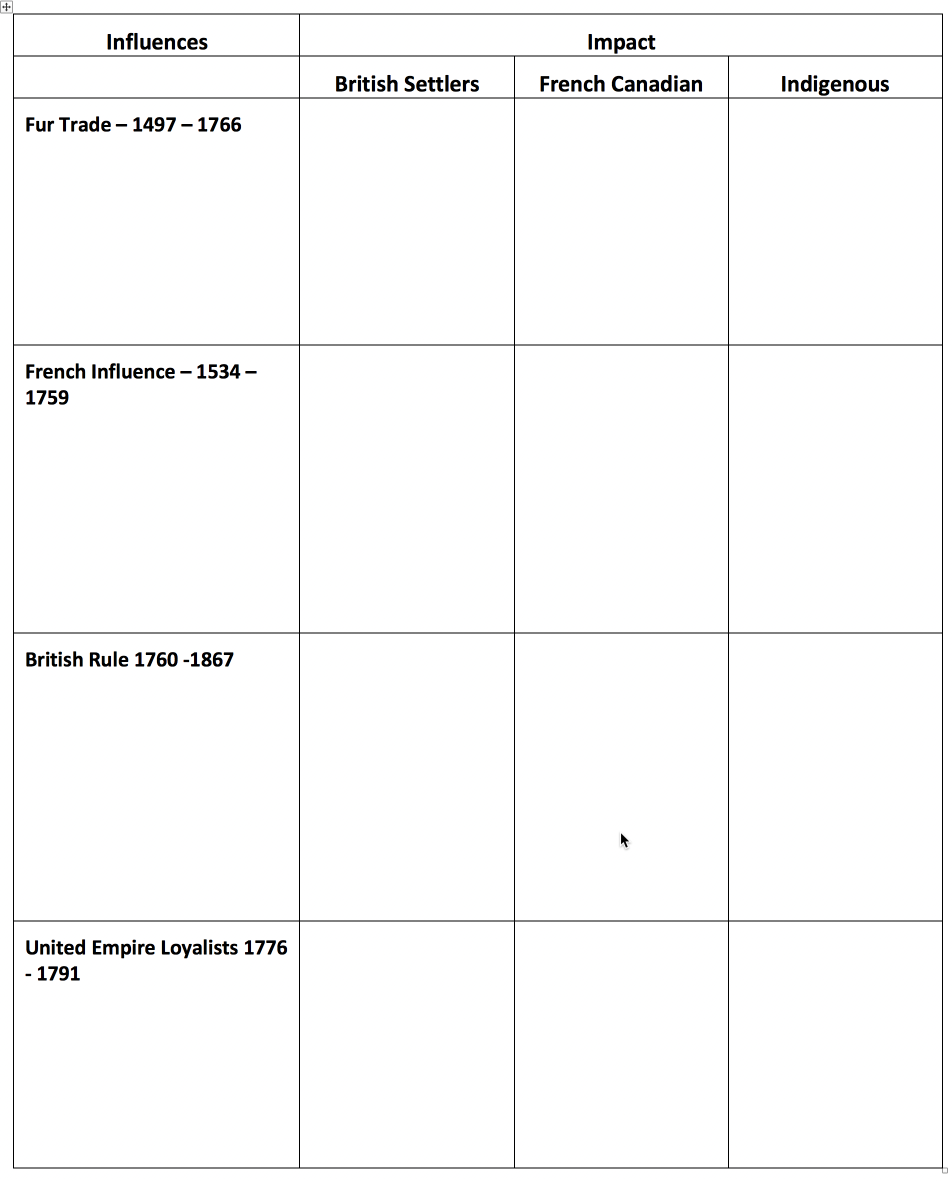
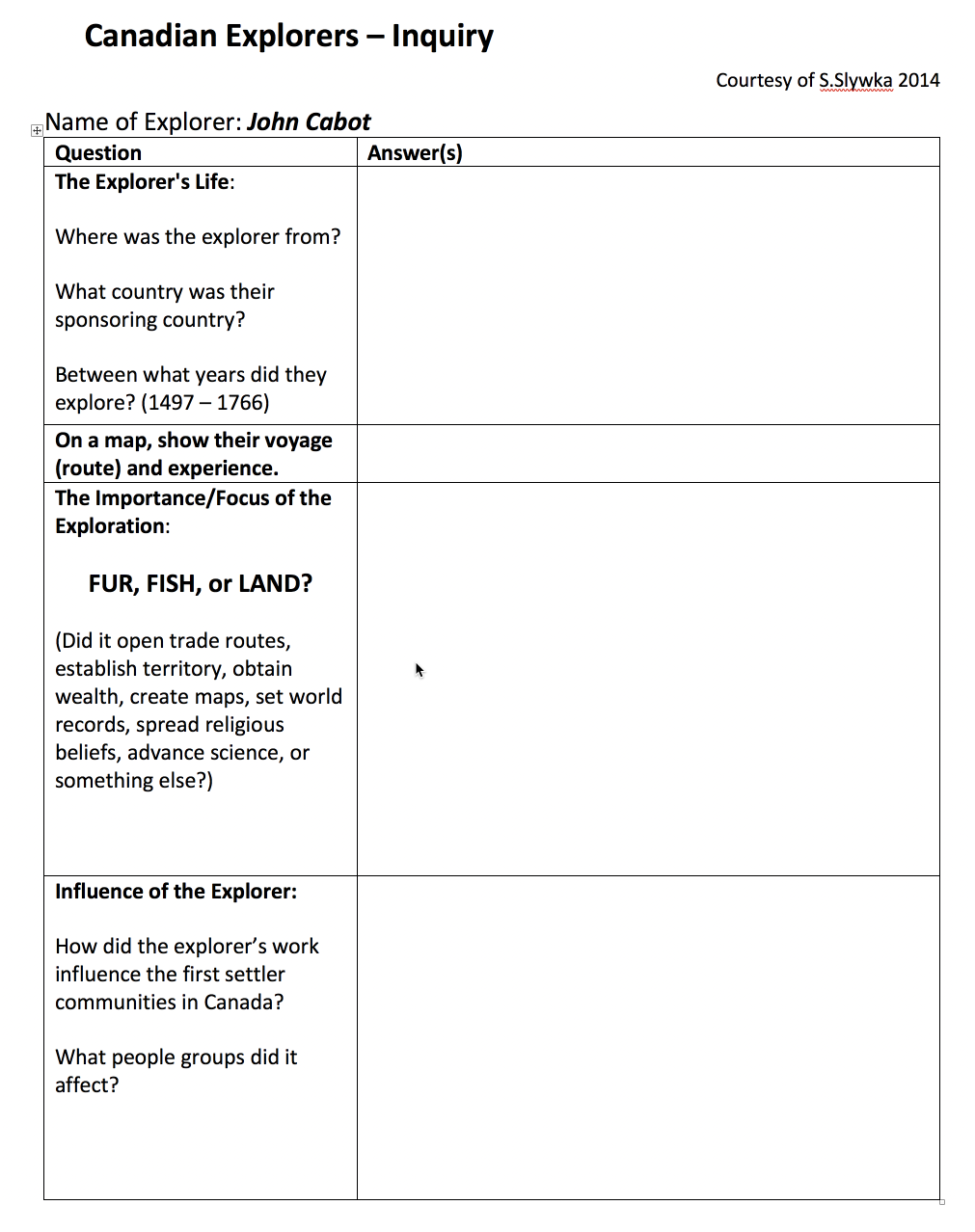
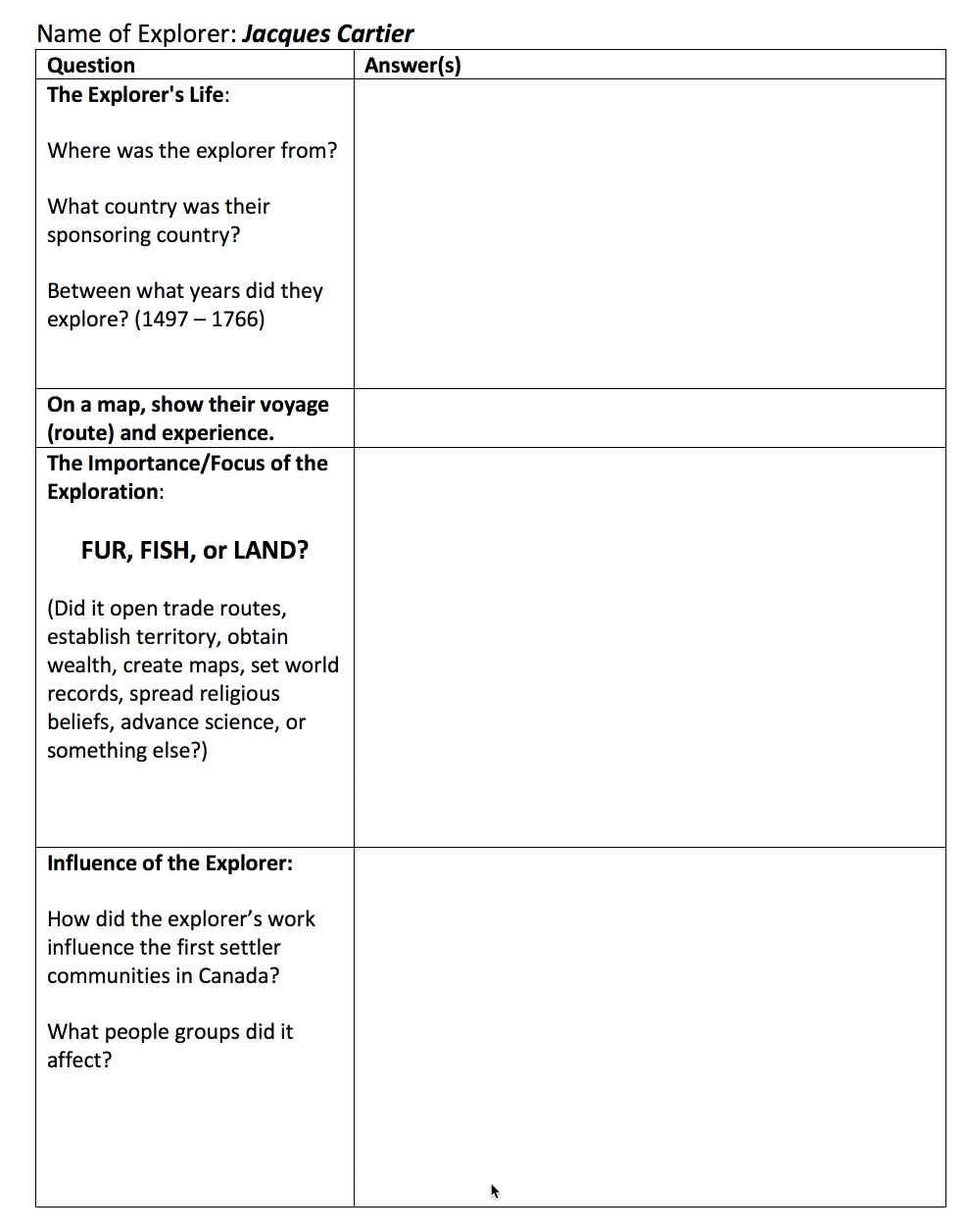
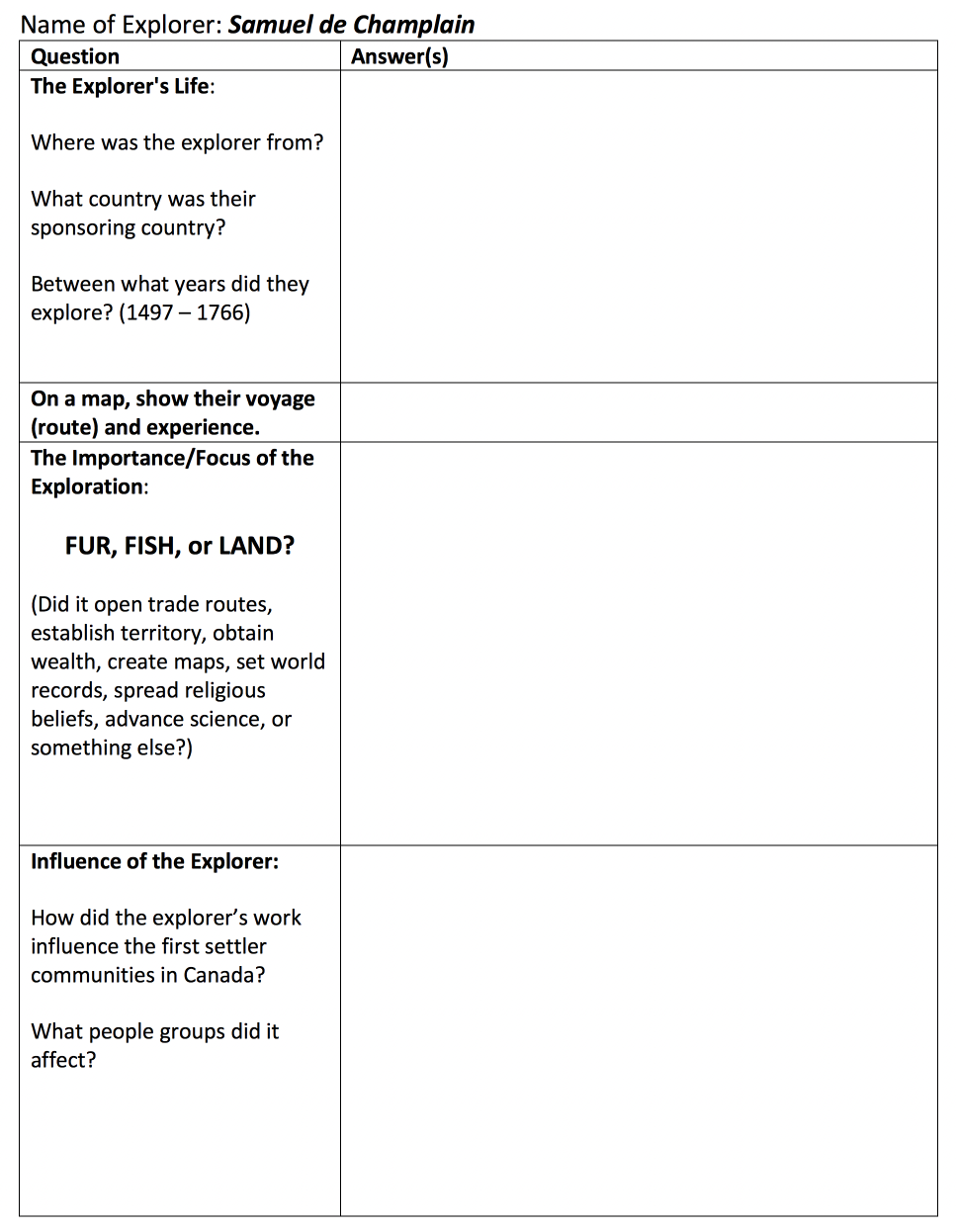
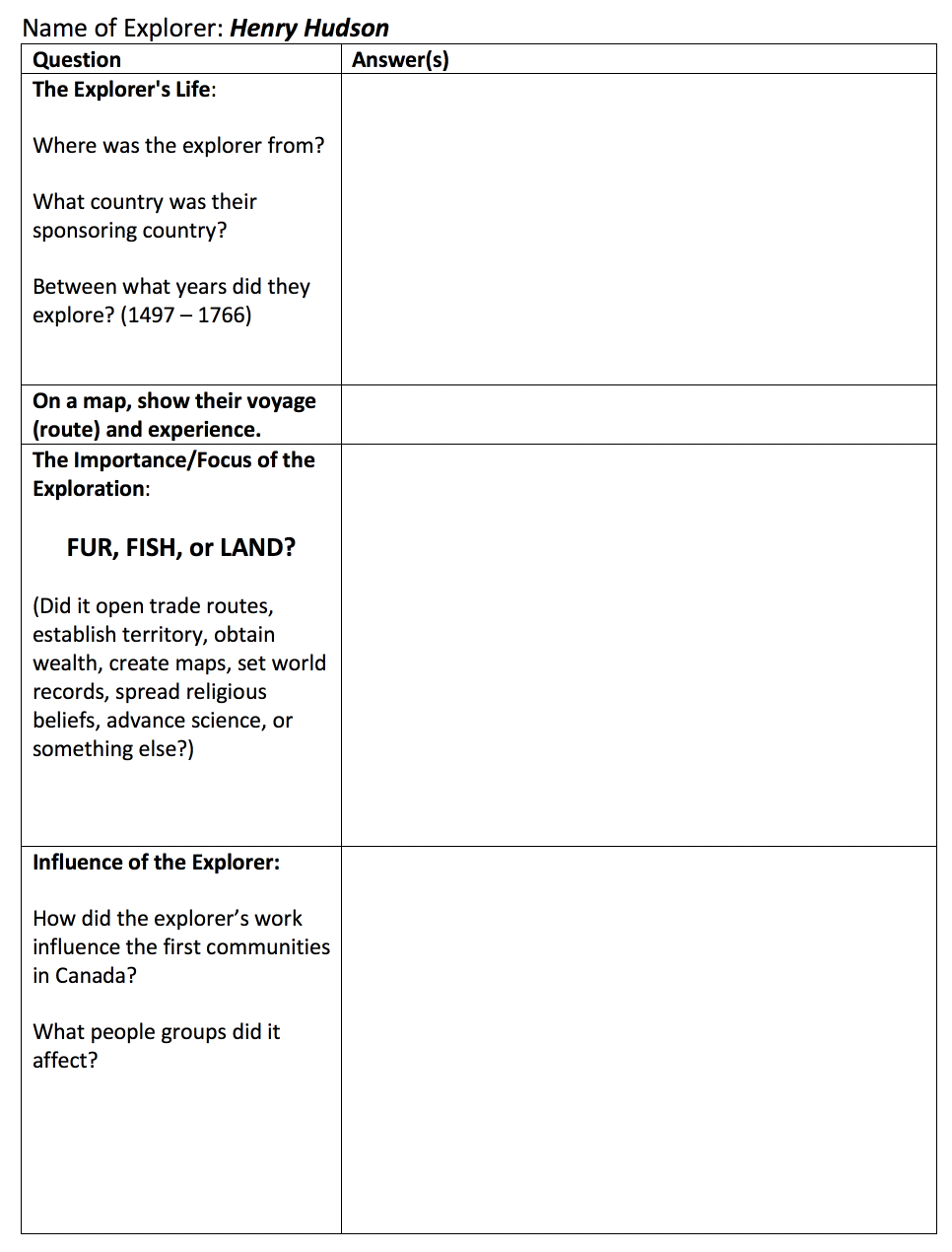
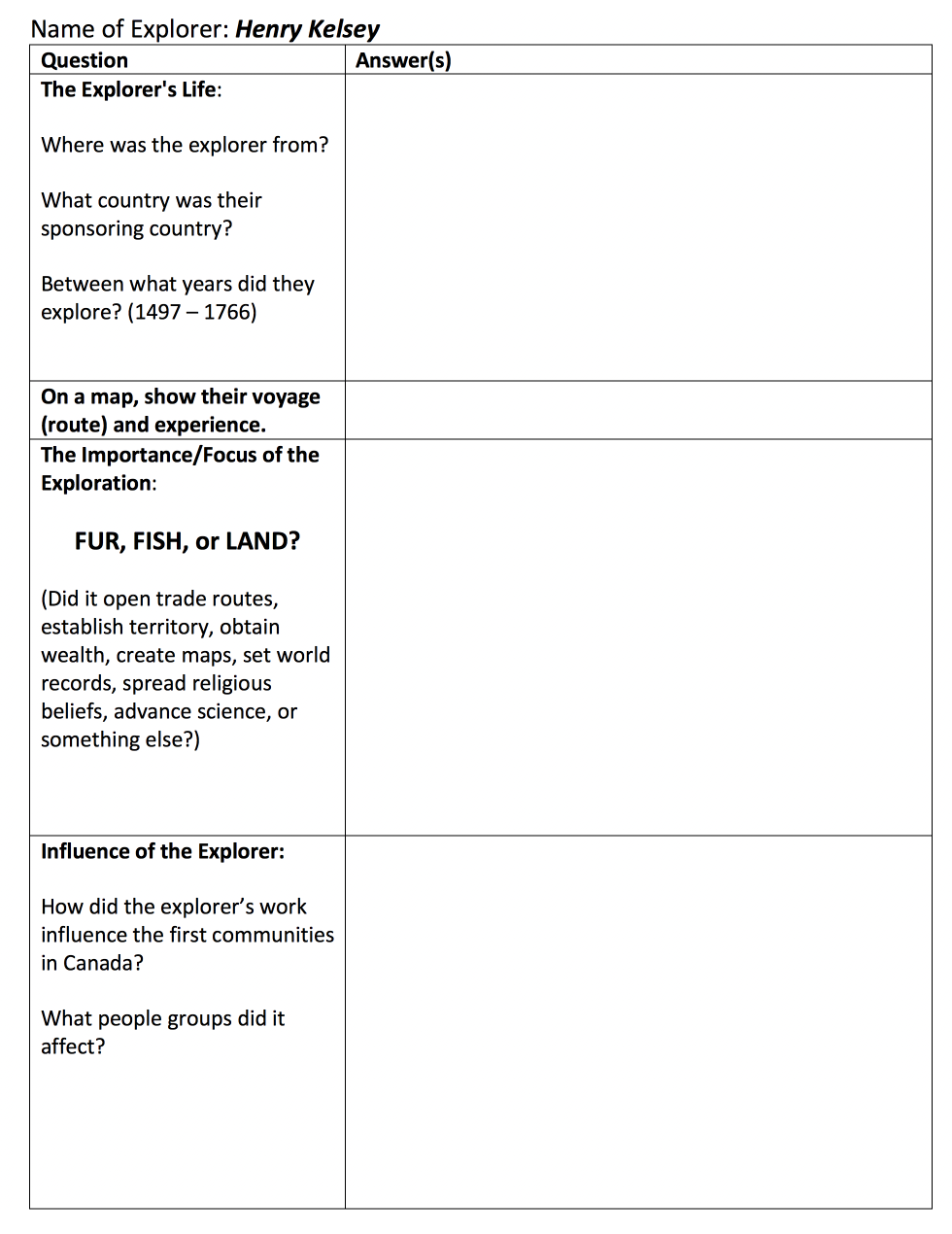
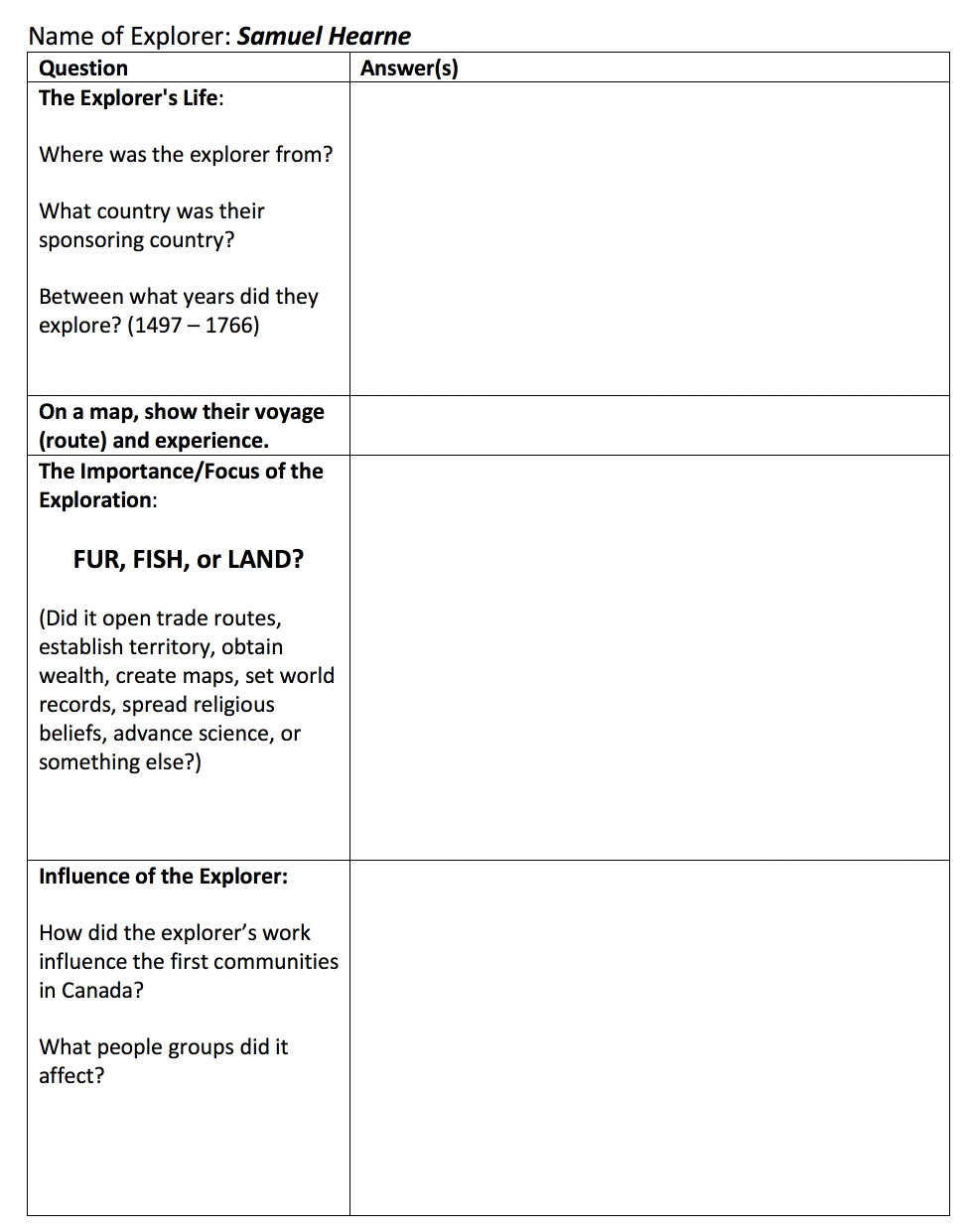
GRADE 5 CITIZENSHIP STUDIES SELF, COMMUNITY, AND PLACE
Part A: Curricular Connections and Background
BROAD AREA OF CITIZENSHIP
A person’s “sense of place” develops through experience and knowledge of the history, geography and geology of an area, the legends of a place, and a sense of the land and its history after living there for a time. Developing a sense of place helps students identify with their region and with each other. A strong sense of place can lead to more sensitive stewardship of our cultural history and natural environment.
OVERVIEW AND DESIRED RESULTS OF CITIZENSHIP STUDY
They will learn about the various cultures that have shaped Saskatchewan communities; analyze the contributions of First Nations and Métis people to the province, historically and currently; and, learn about the influence that the climate and geography of Saskatchewan had on the decisions made by the people and the development of the province.
They consider the importance of the environment and the contemporary influences on the sustainable management of Canada’s environment. Finally students are also asked to think about possible economic changes that may impact Canada. Students will continue to examine decisions made and consider the consequences of those decisions.
Students will actively engage in:
- Understanding the dynamics of change and seek information and skills for action;
- Developing a critical understanding of and actively exploring and analyzing events and the effects of decisions on a local, national and global level.
ENDURING UNDERSTANDINGS OF CITIZENSHIP STUDY
- Decision-making is a complex process with far-reaching impacts and is influenced by history.
- A person’s worldview frames their understanding of the world.
- Citizens value the need of the collective common good and consider how their actions impact the collective well-being.
- Governments and the people who elect them are responsible to one another.
- Empathy and respect for diversity in cultural and social groups help strengthen one’s community and requires appreciation of different perspectives.
- Individuals have the power to affect others and make a difference.
- Canada has a long relationship with First Nations Peoples through treaty relationships.
- Canada has a constitutional responsibility to support First Nation, Métis and Inuit people.
- Societies create rules, written and unwritten, to promote order that lead to inclusion or exclusion and are enforced by social behaviours and expectations.
- Belonging requires participation and is a fundamental right of all citizens.
- Active citizens become engaged in discussions, negotiations, debates and consider action regarding Canadian issues.
Inferences to make:
- Positive collective action enhances self-esteem
- Empathy requires understanding and appreciating another person’s perspective
- Societies create rules – written and unwritten – that lead to inclusion or exclusion and are enforced by social behaviours and expectations/actions.
- Citizens value the need of the collective common good and consider how their actions impact the collective well-being.
- Enduring understandings and questions stimulate thinking, guide the inquiry and are linked to outcomes.
- They point to the “big ideas” in the area of inquiry and should be considered and reconsidered as the inquiry progresses.
- Answers to these questions form the evidence of learning at the end of study.
KNOWLEDGE AND SKILL DEVELOPMENT
- How empathy and sympathy are different
- How to compare and contrast
- How to look for alternate points of view
- How to examine an issue from a variety of perspectives
Students will continue to develop skills for:
- Examining issues from a variety of perspectives
- Looking for alternate points of view
Students will use their independent learning to:
- Develop skills for treating self and others with respect
- Demonstrate empathy in social situations
- Continually reassess where they belong (changing contexts/roles and expectations) i.e. school, family, community
- Reflect upon the impact of their choices
ESSENTIAL QUESTIONS
- How do you control the impact of your actions/decisions?
- What responsibility do you have to balance personal needs with the community’s needs?
- What is the power and responsibility of the individual to can make a difference in the world?
- What are the rules for belonging and how are they developed and enforced?
- What role does empathy play in citizenship?
CURRICULUM OUTCOMES AND INDICATORS
(Sask. Curriculum/Student Friendly)
DR5.2
Assess the impact of the environment on the lives of people living in Canada: Examine the relationship between the environment and Citizens of Canada.
Indicators:
- Describe the climate of different regions of Canada, and investigate how population distribution in Canada is related to climate, resources, and topographical features.
- Explain how different traditional worldviews of Earth affect the use of resources in Canada (e.g., Indigenous and European attitudes toward ownership, Treaties, Crown land, homesteads, and the seigniorial system).
- Investigate the relationship of various First Nations peoples with the environment, including economic relationships, migration, and settlement patterns prior to Confederation.
- Investigate maps from the Métis National Council to determine the recognized homelands of the Métis in Canada.
RW 5.1
Explain the importance of sustainable management of the environment to Canada’s future: Examine the practices of sustainable management by Canadians.
Indicators:
- Differentiate between renewable resources (e.g., forests, fish, water) and non-renewable resources (e.g., oil, minerals).
- Create an inventory of current non-sustainable practices (e.g., presence of plastics, packaging, dumping of waste into river systems).
- List the possible consequences of non-sustainable practices related to the use of resources (e.g., lack of resources for future generations, endangered species, climate change).
- Taking one resource as an example, illustrate how resource use and the extraction process of the resource affects the environment (e.g., forests, tar sands, coal, uranium, potash).
- Give examples of policies and actions that contribute to sustainability (e.g., water conservation, informed decisions by consumers, reusing materials).
RW 5.2
Hypothesize about the economic changes that Canada may experience in the future: Consider the economic changes that Canada may experience.
Indicators:
- Using factual data and statistics, predict the future demographic make-up of Canada (e.g., growth in senior citizen population, Indigenous populations, rates of immigration, birth rates, rural depopulation).
- Describe the effect the movement of people has on local and provincial communities.
- Predict which industries will be of future significance in Canada using factual information, statistics, and other data to support your prediction.
- Give examples of possible changes in Canada’s principal industries (e.g., large agricultural companies replacing family farms; the importance of technological industries).
- Speculate upon how contrasting worldviews toward the natural environment may affect the use of resources. Consider the traditional First Nation worldview model.
Part B: Learning Plan
- Examine their relationship to the environment and consider their actions as Citizens connected to self, community, and place.
- Consider the environmental impact of their decisions on their community, province, nation and world and think about practices for sustaining the environment for future generations.
- Consider possible economic changes Canada may experience in the future.
- Consider how possible economic changes that Canada may impact decisions regarding environmental concerns.
QUESTIONS TO GUIDE INQUIRY
Teachers may want to consider putting the questions into a “Before, During, After” chart to note the changes in students’ thinking as a result of the inquiries.
- How do you control the impact of your actions/decisions?
- How far reaching are the impacts of your actions/decisions?
- What responsibility do you have to balance personal needs with the community’s/global needs?
- Where is the balance between personal good and collective common good?
- What role does worldview play on the use of resources?
- What is the power and responsibility of the individual to make a difference in the world?
- What are the responsibilities of the different levels of government to make a difference in the world?
- How can citizens monitor the leaders of our country and hold them accountable for decisions made?
- What role does empathy play in citizenship?
- What role does empathy play in sustaining the environment?
- Is there a place for empathy in economic development?
CONNECT TO TOPIC AND SURFACE STUDENTS’ THINKING ABOUT …
- Pose the essential and guiding questions and allow students to discuss their thoughts on the matter.
- Determine what the students know, understand, need to be able to do to master/answer the essential questions (connect to content). Additional guiding questions can be added as required. Students are encouraged to add their questions to the others.
- Create Know, Want to know, Learned Chart – identify vocabulary that requires development
- Surface any additional questions students might have as a result of their discussions about the essential questions.
- How do you control the impact of your actions/decisions?
- How far reaching are the impacts of your actions/decisions?
- What responsibility do you have to balance personal needs with the community’s/global needs?
- Where is the balance between personal good and collective common good?
- What role does worldview play on the use of resources?
- What is the power and responsibility of the individual to make a difference in the world?
Students have been talking about influences on decision-making and considerations that make decisions solid/good decisions.
Ask students to list the decisions they make in a day, week. i.e. clothing worn; programs watched; music listened to; food eaten; games played. Identify and list the influences to those decisions.
Have students complete a questionnaire that could be used again at the end of the unit. Responses are:
Usually Sometimes Hardly ever.
1. Do you use reusable water bottles?
2. Do you use reusable lunch containers?
3. Do you microwave your lunch?
4. If you go to get a slurpie, do you reuse your cup or bring your own cup?
5. Does it matter to you where your clothing comes from?
6. Do you wear brand name clothing?
7. Do you use both sides of the paper?
8. Do you use the paper-recycling bin in your classroom?
9. Do you remember to turn the light off when you leave a room?
10. Do you use your bike to go to your friend’s house?
Post the results and ask students to rate the class’s sustainability practices. Why do they choose to be at this level? Process – Understanding geographic areas of Sask.
DEVELOPING UNDERSTANDING
Explain the importance for Canadians to sustainably manage their environment.
Concept Clarification- Inside the circle/Outside the circle Classification Process
Have students determine the reasons for the inclusion of words within and outside of the circle. Develop a definition of renewable and non-renewable. Use the Frayer model (Definition, Characteristics, Examples, Non-examples) to further clarify and demonstrate student understanding.
Renewable – Non-renewable
Inside the circle –renewable resources – forests, fish, water
Outside the circle – non-renewable resources – oil, minerals, coal, potash
Sustainable – non-sustainable
Students will apply their understanding of these terms in the following studies.
Examining how Canadians use our resources
Have groups of students:
- Choose a resource that students use regularly from the classification exercise above (Resource examples – forests, tar sands, coal, uranium, potash, water).
- Identify the resource as either renewable or non-renewable.
- Trace the processes for extraction of that resource.
- Show how the extraction of the resource impacts the environment.
- Present their information to the class – identify the impacts on the environment and begin to list and categorize the practices to acquire and use those resources according to sustainability and non-sustainability for the environment.
Based on the research and presentations have student groups develop a statement that summarizes how Canadians use our resources. Is it sustainable? What does our use of resources say about our relationship with the environment? What does our use of resources say about our beliefs regarding the use of the environment? Worldview of the environment?
- What role does worldview play on the use of resources?
Vocabulary
- climate
- sustainable/sustainability
- non-sustainable
- common good
- population distribution
- resources
- renewable
- nonrenewable
- geography
- topography
- demographics
- environmental footprint
EVIDENCE OF LEARNING
List the possible consequences of non-sustainable practices related to the use of resources (e.g., lack of resources for future generations, endangered species, climate change).
Citizen reaction
In groups have students identify policies and actions that contribute to sustainability (e.g., water conservation, informed decisions by consumers, reusing materials).
DR5.2
Examine the relationship between the environment and the lifestyle choices of the Citizens of Canada.
Have students discuss:
- Why do people live where they live?
- What influences a person’s decision to move to a specific location?
- What is the relationship between the environment and the Canadian economy?
Jigsaw Research and Study Process
Divide class into groups and give each group a specific climate area to learn about and present to class. Each group must find out the information in the questions posed below. Encourage students to present information learned in a variety of modes including speaking, writing, drama, multimedia, or other modes so that all students have an entrance point for demonstrating their learning and understanding. (i.e. a travel brochure, video, etc.)
Canadian Climate investigation
Canada has 7 different climate regions
– Pacific, Cordilleran, Atlantic, Great Lakes/St. Lawrence Low, Prairie, Boreal, Arctic
Assign each group of students a particular region. Have students identify the:
- location and area of Canada and describe the geography/topography
- climate of the specific region and the causes for the climate
- population of the region, numbers, demographics
- resources available in the region
- economy of the region
Have students re-visit the questions. How has their thinking changed?
- Why do people live where they live?
- What influences a person’s decision to move to a specific location?
- What is the relationship between the environment, resources, and the Canadian economy?
See appendix for climate graphic organizer.
Resource Use – Have students compare and contrast use of resources and identify the effect of worldview on resource use.
Divide the class in half. Assign each group a specific research perspective. Have students identify the respective beliefs for each area and provide examples of those beliefs in action. For insight into traditional First Nation worldview, use the resource, Treaty Essential Learnings: We Are All Treaty People.
EVIDENCE OF LEARNING
- What were the similarities between the two worldviews? What are the differences?
- Why are Indigenous people considered natural stewards of the land?
- What is the relationship between Canada’s environment and the distribution of population and economy? Develop a synopsis statement from each Worldview perspective – Indigenous and European.
- Speculate upon how contrasting worldviews toward the natural environment may affect the use of resources. Develop a motto or slogan from each perspective.
APPLY AND EXTEND KNOWLEDGE
- Elder
- Conservationist
- Botanist
- Chamber of Commerce Representative
- Governance Councillor
Consider the future economic changes that Canada may experience.
Future Predictions – using the Jigsaw Research and Study process have students research one of the areas and provide information for the class.
Study the current demographic and industrial make-up of Canada in the following specific areas.
- Senior citizen population
- Indigenous populations and traditional territories
- Birth rates
- Immigration rates
- Rural vs. Urban population
- Industrial Trends
- Resource Industries
- Technological Industries
- Economic Industries
Identify the process:
- current situation,
- make a future prediction,
- identify the specific climate areas affected,
- substantiate with evidence.
EVIDENCE OF LEARNING
- Consider possible effects/implications of your predictions on the local and provincial communities.
- Suggest counteractive strategies to protect the environment and reduce the environmental footprint.
- Identify steps to implement those strategies.
- Present their thinking to the class.
APPLY AND EXTEND KNOWLEDGE
- From the list of survey questions (pg. 9) discuss the impact of their actions and consider alternate practices. Identify the steps to implement those practices.
- Suggest strategies for getting citizens to live in a more environmental sustainable way.
- Choose an existing governmental policy or strategy that is intended to impact resources and the environment. Identify the pros and cons of the policy/strategy and suggest ways to strengthen it.
Revisit the initial student thinking on the essential questions. Note how the thinking has changed.
- How do you control the impact of your actions/decisions?
- How far reaching are the impacts of your actions/decisions?
- What implications does this knowledge have for your actions?
- What responsibility do you have to balance personal needs with the community’s/global needs?
- Where is the balance between personal good and collective common good?
- What is the power and responsibility of the individual to make a difference in the world?
- What role does empathy play in citizenship?
- What role does empathy play in sustaining the environment?
- Is there a place for empathy in economic development?
- Why are treaty relationships important to all Canadians?
- What are the benefits of understanding treaty promises?
- What are the hazards of not understanding treaty promises?
STUDENT CITIZENSHIP JOURNAL OPPORTUNITIES
- Reflect on the role that sustainability plays in citizenship.
- Reflect on your beliefs and actions. Do they demonstrate empathy for the environment? What examples do you have to support your thinking?
- How would you rate yourself as a citizen who cares about the environment? What examples do you have to support your rating? What would it take to become better?
- Why do humans engage in non-sustainable practices? What would it take to change people’s practices?
- What is a citizen’s responsibility to the environment?
Part C: Self, Community, and Place Resources
LESSON RESOURCES
- Canadian Teachers’ Federation. Social Action Projects: Making a Difference. K-4. 5-8.
- Canadian Teachers’ Federation. Engaging in Our Communities… as Global Citizens. A citizenship education initiative centered on the values of the environment, democracy, peace and solidarity.
- Case, Roland. Active Citizenship: Student Action Projects. A framework for elementary and secondary teachers to help students plan and implement responsible social action. The Critical Thinking Consortium. 2004.(this resource has some rubrics that could be used.)
- Office of the Treaty Commissioner www.otc.ca
- Our Country Our Parliament – http://www.parl.gc.ca/About/Parliament/Education/OurCountryOurParliament/pdfs/Booklet-e.pdf
- Virtual Museum of Canada – http://www.museevirtuel-virtualmuseum.ca/index-eng.jsp – Discover arts, science and Canadian history via entertaining and diverse multimedia museum web productions.
- Back to Batoche – http://www.museevirtuel-virtualmuseum.ca/sgc-cms/expositions-exhibitions/batoche/html/about/index.php
- First Nations Governance – http://fngovernance.org/publication_docs/Five_Pillars_CFNG.pdf
- Canada’s Democracy – Elementary Education Guide
http://www.democracy-democratie.ca/res/edres/lps/elp-01_e.pdf - Indigenous People Highlight Tables, 2016 Census
http://www12.statcan.gc.ca/census-recensement/2016/dp-pd/hlt-fst/abo-aut/Table.cfm?Lang=Eng&T=101&S=99&O=A - The Nystrom Atlas of Canada and the World – pgs 44 – 71
- Canada: It’s Land and People (Second Edition) by Don Massey and Patricia N. Shields, 1995, Reidmore Books
- Google: Physical Geographic Regions of Canada + kids https://web.archive.org/web/20180421191835/http://hrsbstaff.ednet.ns.ca/phillie/InternationalExchange/Canada/Physical%20Regions/Physical_Regions/
- Pearson Sask Social Studies text – section on the 7 Canadian Climate Regions:
- Canadian Issues: Should Canada Build Pipelines in the United States?, 2013, Weigl Educational Publishers Ltd.
- Physical Regions of Canada
http://web2.uwindsor.ca/edfac/student/griff-3.htm
CROSS CURRICULAR CONNECTIONS
Themes
- Personal and Philosophical: Students will:
- believe in their own self-worth and feel that they have control over the things that happen to them;
- look inward and focus on self-image and self-esteem; and,
- reflect on self and life, and on their beliefs and values and those of their society.
- Social, Cultural, and Historical: Students will:
- look outward and examine their relationships with others, their community, and the world;
- consider the social and historical context;
- explore their connections in families, schools, groups, and communities to understand the diverse needs and wants of others; and,
- show concern for other people in their relationships, groups, and communities.
- Environmental and Technological: Students will:
- explore the elements of the natural and constructed worlds and the role of technology and related developments in their society; and,
- explore the needs and characteristics of living things; properties of objects and materials; the five senses; and daily seasonal changes.
- Communicative: Students will:
- consider the role of communication in their lives and the technologies and strategies that help people become effective communicators; and,
- practice the skills to interact effectively with others.
Treaty Education
- TR5: Examine the concepts of colonization and decolonization and analyze their effects.
- SI5: Analyze how symbols used by treaty signatories contributed to the treaty making process.
- HC5: Analyze the concept of self-government as it applies to First Nation and Métis people.
- TPP5: Analyze the benefits of treaties for all people in Saskatchewan from a contemporary perspective.
Health
Understanding, Skills, and Confidences (USC)
- USC5.5 Analyze the impact of violence and the cycle of abuse on the holistic well-being of self, family, and community.
- USC5.7 Assess the importance of self-regulation and taking responsibility for one’s actions.
Decision Making (DM)
- DM5.1 Analyze possible obstacles and envision solutions to addressing health challenges related to personal eating practices, changes of puberty, impact of illness/disease, identity and well-being, violence, peer pressure, and self-regulation.
Action Planning (AP)
- AP5.1 Design and implement, with guidance, two five-day action plans that embrace health opportunities or address health challenges related to personal eating practices, changes of puberty, impact of illness/disease, identity and well-being, violence, peer pressure, and self-regulation.
Science
Life Science: Human Body Systems (HB)
- HB5.1 Analyze personal and societal requirements for, and the impact of, maintaining a healthy human body. [CP, DM]
Physical Science: Properties and Changes of Materials (MC)
- MC5.3 Assess how the production, use, and disposal of raw materials and manufactured products affects self, society, and the environment. [DM, SI]
Physical Science: Forces and Simple Machines (FM)
- FM5.3 Assess how natural and man-made forces and simple machines affect individuals, society, and the environment. [CP, DM, SI]
Earth and Space Science: Weather (WE)
- WE5.3 Analyze the impact of weather on society and the environment, including technologies that help humans address weather conditions. [DM]
- DR5.2 Examine the relationship between the environment and the lifestyle choices of the Citizens of Canada.
APPENDIX
A. In your groups, discuss the following questions and record your answers in point form.
- Why do people live where they live?
- What influences a person’s decision to move to a specific location?
- What is the relationship between the environment, resources, and the Canadian economy? (economy: the state of a country in terms of the production and consumption of goods and services and the supply of money)


Canadian Climate Region: ______________________________________
(Pacific, Cordilleran, Atlantic, Great Lakes/St.Lawrence Lowland, Prairie, Boreal, Arctic)
Resources to find your Information:
- The Nystrom Atlas of Canada and the World (pgs 44 – 71)
- Canada: It’s Land and People, Don Massey and Patricia Shields – find your chapter in the table of contents
- Google: Physical Geographic Regions of Canada + kids http://hrsbstaff.ednet.ns.ca/phillie/InternationalExchange/Canada/ (link no longer active)
- Physical Regions of Canada
http://web2.uwindsor.ca/edfac/student/griff-3.htm - Location and area of Canada
- The geography of the area
- Climate of the region
- Causes for the climate of the region
- Population of the region in
- Numbers
- Demographics
- Resources in the region
- Economy in the region
C. Revisit the following questions. In your groups, discuss the following questions and record your answers in point form. Think about how your thinking has changed!
- Why do people live where they live?
- What influences a person’s decision to move to a specific location?
- What is the relationship between the environment, resources and the Canadian economy? (economy: the state of a country in terms of the production and consumption of goods and services and the supply of money)
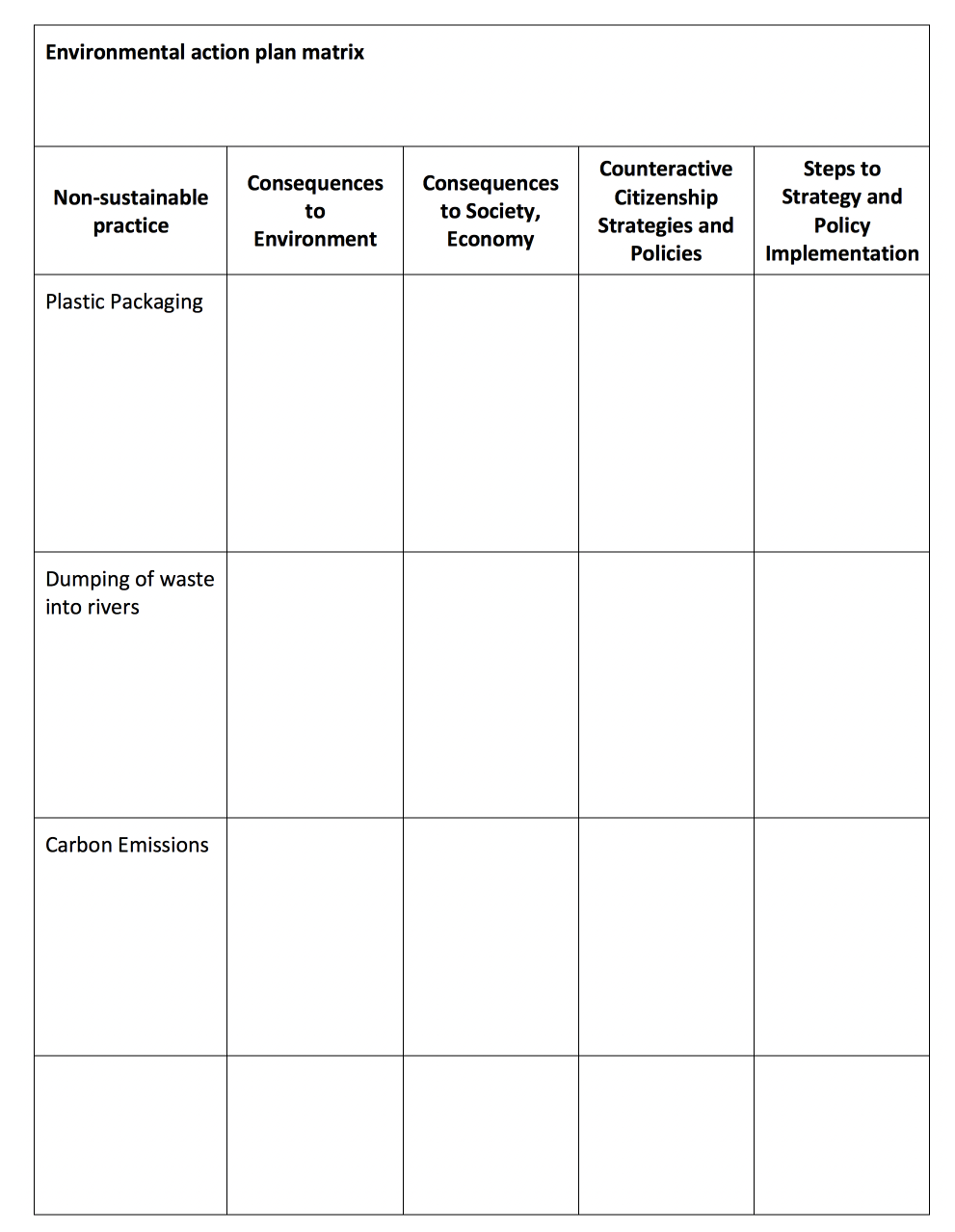
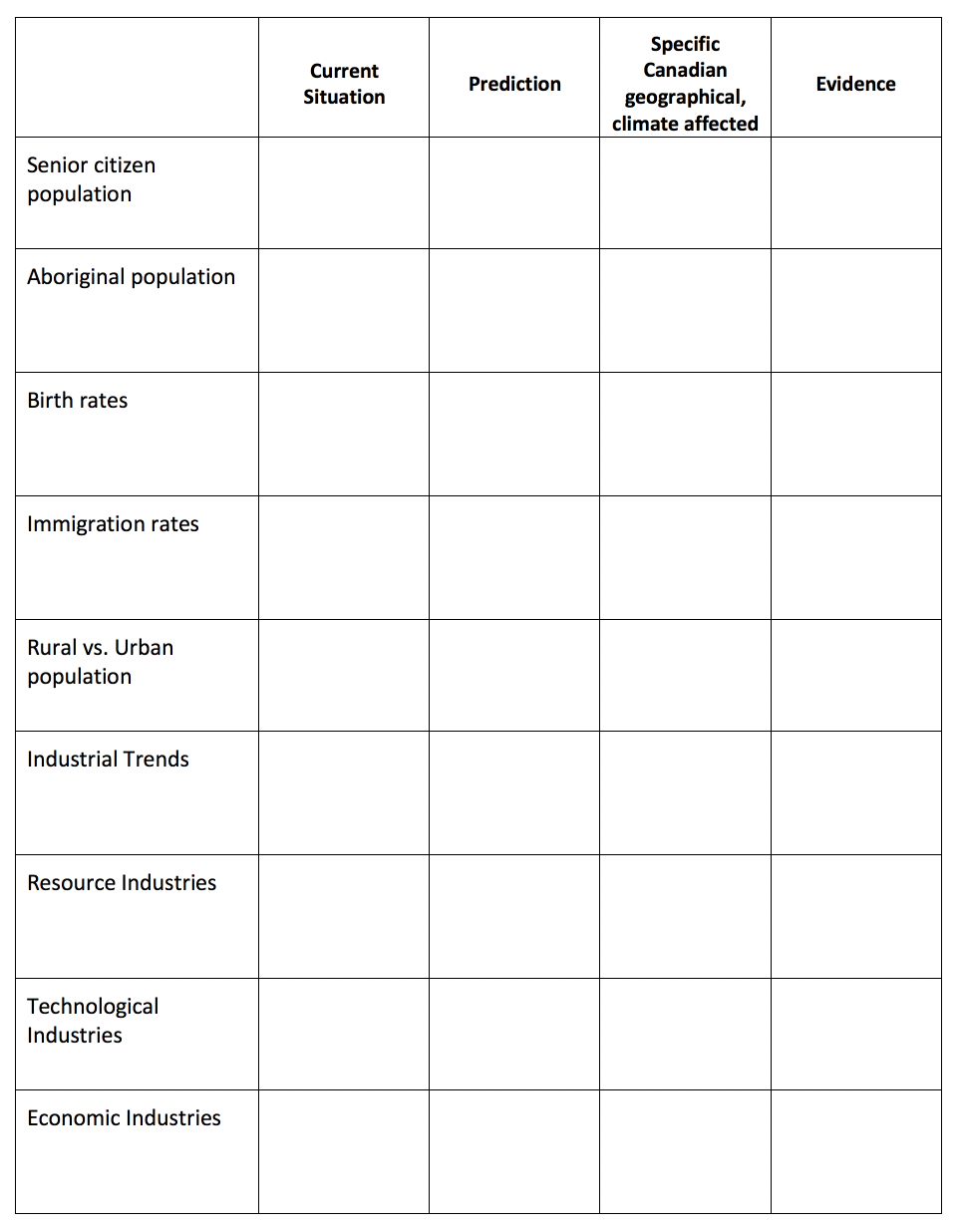
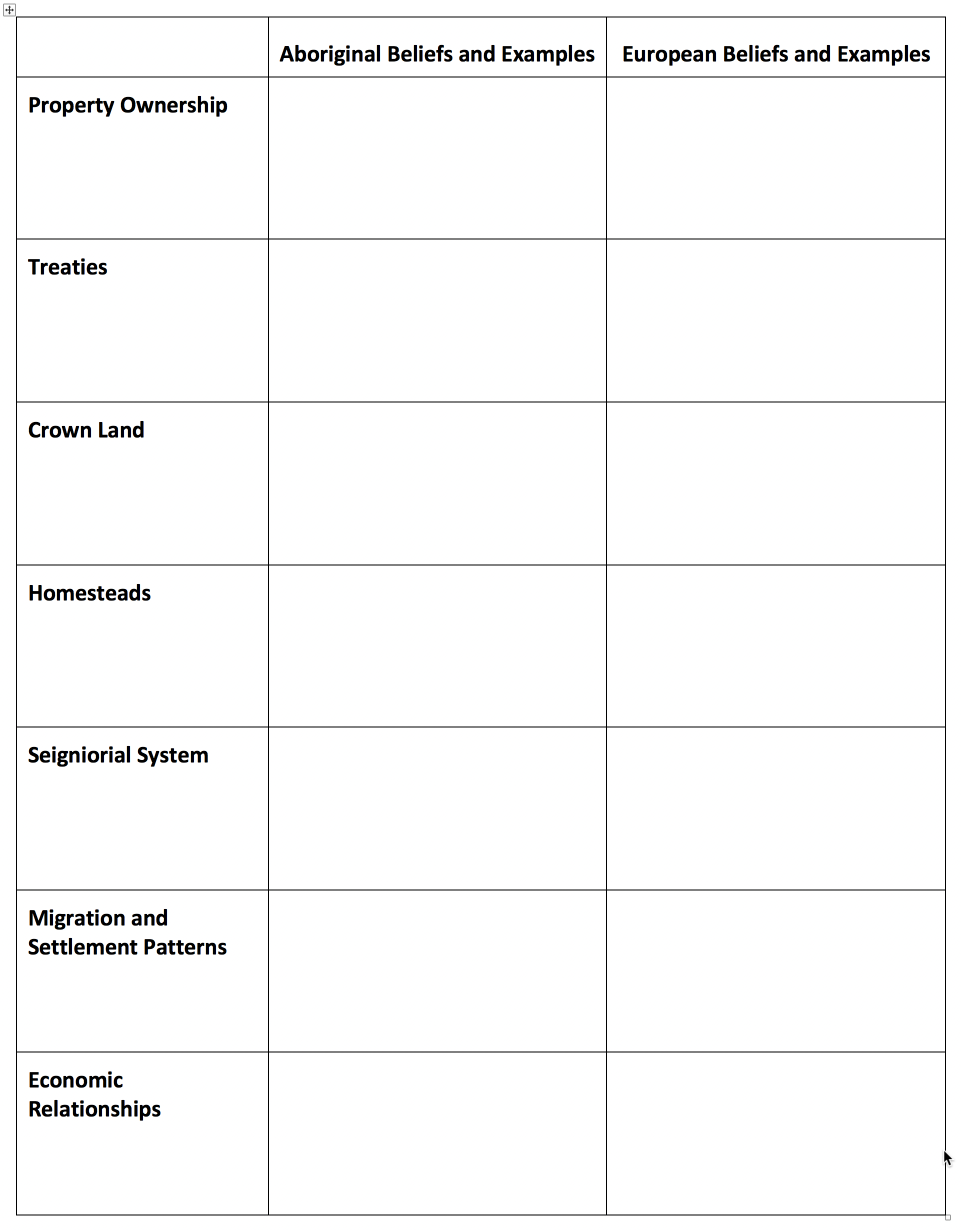
© 2024 Concentus Citizenship Education Foundation Inc. All Rights Reserved.





